Ystalyfera is a former industrial village in the upper Swansea Valley, on the River Tawe, about 13 miles north-east of Swansea. The village grew, like its neighbouring villages, as a result of the coal mines, iron works and tinplate works which sprung up in the area. The original Ystalyfera War Memorial was a cenotaph erected in 1922 in parkland donated by Colonel Gough, above the town. After years of neglect and vandalism, this was taken down and it was agreed to construct a new, more central, war memorial in Commercial Street, Ystalyfera. On 24 July 1983, in a ceremony overseen by the Bishop of Swansea and Brecon, this new memorial was dedicated. I do not presently have any photographs of the memorial, so one would be appreciated.
The Great War, 1914-1918
Benjamin Ambridge, Fireman, 912971, Mercantile Marine Reserve. Benjamin was the son of Benjamin and Mary Ann Ambridge, of Ynisdarren Road, Ystalyfera. He married Rosey Cady at Swansea in 1915 and the couple lived at 3, Rosehill Cottage, Trehearne Road, Morriston. Benjamin enlisted into the Mercantile Marine Reserve and was posted aboard the steamship RFA Industry. While he was away at sea, the couples’ young son, Benjamin Verdun Ambridge, died on 13 May 1917 aged just 14 months. On 18 October 1918 Industry was in the Irish Sea under escort, when she was torpedoed and sunk near Strangford Light Buoy by the German submarine UB-92, with the loss of 21 of her crew. Benjamin was 23 years old when he died during the sinking and is commemorated on panel 30 of the Plymouth Naval Memorial, Devon.
Daniel John Austin, Private, 17570, Welsh Regiment. Daniel was the son of William and Mary Austin, of Swansea. He married Mary Mochan at Ystalyfera on 4 May 1910 and the couple had four children over the coming years prior to the war, despite Daniel spending some time in HM Prison, Brecon. He enlisted into the 5th Battalion, South Wales Borderers at Ystradgynlais on 3 October 1914, but was discharged as medically unfit three weeks later. Daniel then re-enlisted at Swansea into the 14th Battalion, Welsh Regiment, which was known as the Swansea Pals battalion, and trained at Rhyl and Winchester before landing in France on 2 December 1915 attached to 114 Brigade, 38th (Welsh) Division. The division moved to the Fleurbaix area for trench initiation, then spent time holding various sectors down towards Cuinchy and by June 1916 was holding the line near Laventie. On 4 June 1916 the battalion sent out a raiding party which came into contact with the Germans in No Man’s Land and suffered the deaths of Lieutenant Corker and one man killed, one missing and another man wounded. Daniel was probably the man wounded during the raid, as he died of his wounds on the following day, 5 June 1916, aged 29. He is buried in grave II.H.5. in Royal Irish Rifles Graveyard, Laventie, France. His widow, Mary, married William Jones in 1918, and the couple lived at 4, Tudor Street, Garden City, Ystradgynlais.
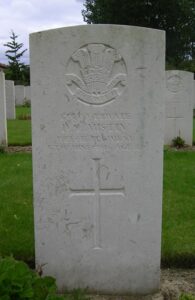
Lewis Westcott Smith Baker, Driver, W/2939, Royal Field Artillery. Lewis was the son of Joseph and Annie Elizabeth Baker, of The Pavement, Hay, Breconshire. He worked in the office of the Gurnos Colliery and resided with Mr Page, at Alltygrug Road, Ystalyfera. Lewis enlisted at Swansea into the 38th (Welsh) Division, Royal Field Artillery and was posted to D/119th Brigade, landing in France on 24 December 1915. The division was initiated into trench warfare in the Fleurbaix sector and held various sections of the line down towards Cuinchy before marching south to the Somme in June 1916 to take part in the assault on the staunchly defended Mametz Wood. Following heavy losses to the division during the capture of the wood, the division was moved north and took up positions north of Ypres, along the Boesinghe Canal, which it remained in for the coming twelve months. Lewis was killed in action here on 20 June 1917, aged 22. He is buried in grave I.P.28. in Railway Dugouts Burial Ground (Transport Farm), Belgium. Lewis is also commemorated on the Hay War Memorial. A brother, Harold Baker, was killed at Gallipoli in 1915 whilst serving with the AIF.
Edward Forster Bates, Private, 38563, Welsh Regiment. Edward was born at Newcastle-on-Tyne in 1877, the son of James Stephen Bates and Kate Mary Bates. He was living in London prior to the turn of the century and married Gertrude Isabella Seyle on 28 April 1900. By 1911 the family was living at Llandebie and then moved to 6 Cwmtawe Place, Godrergraig. Edward worked as a coal miner before enlisting at Swansea into the 3rd Battalion, Welsh Regiment on 20 July 1915. He was then posted to Rhyl, joining the 14th Battalion, Welsh Regiment (Swansea Pals), which was undergoing a scheme of training. Edward did not embark for France with the battalion on 2 December 1915 but remained in Britain. He was found to have contracted tuberculosis and was discharged as medically unfit on 25 February 1916. He died of tuberculosis at home during the spring of 1918, aged 43. Edward is not commemorated as a war casualty by the CWGC as his condition was deemed to have not been brought about by his wartime service, despite his attempts to gain a pension.
Thomas Boyd, Private, 2805, South Wales Borderers. Thomas was from Liverpool and had served with the Cheshire Regiment for several years after having enlisted in 1883, seeing service in Burma and China, where he was wounded. On 26 August 1895 he was discharged, after having served for twelve years, and moved to Godrergraig where he married Kate Elizabeth Sexton on 5 January 1897. Thomas re-enlisted into the Royal Garrison Regiment at Brecon on 16 March 1901 and served for three years again until being discharged and returned to Ystalyfera. He re-enlisted into the Brecknockshire Battalion, South Wales Borderers at Ystradgynlais on 19 October 1914, but his health had started to deteriorate and he was discharged on 28 June 1916 after being diagnosed as suffering from heart disease. By now the couple were living with their two children at 277, Tarreni Terrace. Thomas died as a result of his heart condition on 16 March 1918, aged 52. He is not commemorated as a war casualty by the CWGC as his condition was not deemed to have been caused by his military service. He is buried in Holy Trinity Cemetery, Godrergraig
William Charles, Private, 43241, Leicestershire Regiment. William was the son of Thomas and Esther Charles, of Penygraig Farm, Godrergraig. He worked at the Tarreni Colliery prior to enlisting at Swansea into the Welsh Regiment and served with the 10th Battalion, Welsh Regiment before the battalion was disbanded on 6 February 1918, and was transferred to the 11th Battalion, Leicestershire Regiment, which had been in France since March 1916, as the Pioneer Battalion of the 6th Division. In the spring of 1918 the Division was one of those hit by the German Offensive on the Somme, which had been launched on 21 March, and saw heavy fighting before moving to Flanders to rest, but the following month the Germans launched another offensive on the Lys, and the Division again got caught up in desperate fighting. During August 1918 the Allies had recovered sufficiently to be able to launch their own attacks on the Germans, and after a brilliant victory at Villers Bretonneux on 8 August, attacks were launched at Albert. The 6th Division took part in the Advance in Flanders, before moving south, where they took part in the advance on the Hindenburg Line. William was killed in action prior to this move south, during the advance from Ypres on 7 August 1918, aged 25. He is buried in grave VI.C.2. in Perth Cemetery (China Wall), Belgium.
William Elwyn Clee, Guardsman, 1842, Welsh Guards. William was the son of David and Mary Clee, of Pantteg, Ystalyfera. He enlisted at Swansea into the Welsh Guards and was posted to the 1st Battalion, Welsh Guards early in 1916 following the Welsh Guards baptism of fire at Loos the previous year. William was badly wounded by shrapnel early on in the Somme offensive and spent several months recuperating in the London General Hospital before re-joining the battalion. William probably got back into action with the Welsh Guards during its assault on the Pilckem Ridge on 31 July 1917. The Guards fought throughout most of the Third Battle of Ypres, before moving to the Cambrai front, where the division took part in the Battle of Cambrai. William was killed in action during the German counter-attack, on 1 December 1917, aged 20. He has no known grave and is commemorated on panel 3 of the Cambrai Memorial, Louverval, France.
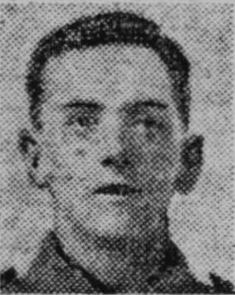
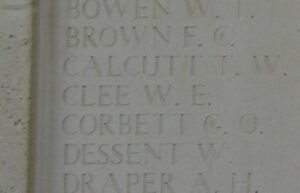
David Mark Cox, Guardsman, 869, Welsh Guards. David was the son of George and Annie Cox, of 6, Chemical Row, Godrergraig. He enlisted at Ystalyfera into the 1st Battalion, Welsh Guards. The Regiment was raised by Royal Warrant of 26 February 1915, at White City, before landing at Le Havre on 18 August 1915, becoming attached to 3rd Guards Brigade, Guards Division. The Division saw its first major action during the Battle of Loos on 25 September 1915, remaining in the area during the coming months, where they also fought in the subsequent Action of Hohenzollern Redoubt. In July 1916 the Division moved to the Somme, where they fought at the Battle of Flers-Courcelette, and then at the Battle of Morval, capturing Lesbouefs Village. They remained here for the winter before moving to Arques for training, then took up positions north of Ypres, from which the division attacked the Pilckem Ridge on 31 July 1917. The Guards remained at Ypres throughout the Third Battle of Ypres, then moved south in order to take part in the Battle of Cambrai, suffering heavily during the German counter-attack. The Welsh Guards remained in the Cambrai sector over the winter, and it was here, during a routine spell in the trenches, that David was killed by a German rifle-grenade on 24 February 1918, aged 20. He is buried in grave II.B.25. in Level Crossing Cemetery, Fampoux, France.
Daniel James Davies, Private, 43794, Welsh Regiment. Daniel was the son of Daniel and Margaret Davies, of 3, Gate Terrace, Godrergraig. He worked as a tinplate catcher prior to enlisting at Cardiff into the Welsh Regiment. Daniel was posted to the 18th Battalion, Welsh Regiment, which was attached to 119 Brigade, 40th (Bantam) Division, and landed in France in June 1916, moving to the front near Loos. Late in 1916 the division moved south to the Somme, where it took part in the Battle of the Ancre and remained in the area over the winter. In March 1917 the Germans withdrew to their shortened line, called the Hindenburg Line, and the 40th Division was one of the Divisions that followed the withdrawal, remaining in this sector for several months. Daniel was killed in action during a routine spell in the line near Gonnelieu on 15 July 1917, aged 23. He is buried in grave I.D.20. in Fins New British Cemetery, Sorel-Le-Grand, France.
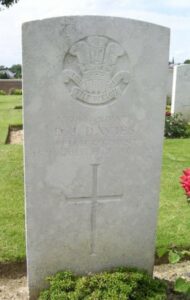
David Davies, Private, 22236, South Wales Borderers. David was the son of Thomas Davies and Margaret Davies. His father died when he was very young, and his mother remarried, moving the family to 3, Beynon’s Row, Ystalyfera. David worked as a collier prior to enlisting at Ystradgynlais into the 11th Battalion, South Wales Borderers. The battalion trained in north Wales before moving to Winchester as part of 115 Brigade, 38th (Welsh) Division, and landed in France on 4 December 1915, taking up the line near Fleurbaix. In June the division marched south to the Somme, where it was tasked with the capture of Mametz Wood. The attack on the wood began on 7 July, but met with fierce resistance, and it took until 14 July to totally clear the wood. The Division suffered terrible casualties at Mametz, and was taken out of the line, and moved to Ypres to rebuild. David was among a number of men from the division to be attached to the 177th Tunnelling Company, Royal Engineers, due to his mining experience, and worked on the construction of deep dugouts and underground mines. He died of jaundice at Ypres on 12 January 1917, aged 34, and is buried in grave I.B.24. in Mendinghem Military Cemetery, Belgium. Jaundice was a side effect of handling the explosives of the day, notably TNT, so he may well have been involved in laying underground mines, a number of which were detonated at Messines Ridge five months after David’s death.
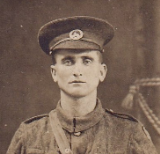
David Davies. David cannot presently be identified.
David Alcwyn Davies, Private, 203315, Royal Welsh Fusiliers. David, known as Alcwyn, was the son of William and Margaret Esther Davies, of 13, Cyfyng Road, Ystalyfera. He worked as a collier prior to enlisting at Ystradgynlais into the South Wales Borderers and was later transferred to the Royal Welsh Fusiliers before being drafted to France, to be posted to the 4th Battalion, Royal Welsh Fusiliers. The battalion had been in France since 6 November 1914, originally with the 1st Division, before becoming the pioneer battalion to the 47th (2nd London) Division on 1 September 1915. The division was north of Arras when the Germans attacked Vimy Ridge in the spring of 1916, and then moved south to the Somme, taking part in the Battle of Flers-Courcelette, and the Battle of Le Transloy, where the Division captured Eaucourt l’Abbé. Early in 1917 the Division moved north to Belgium and took part in the Battle of Messines Ridge. Alcwyn was killed in action whilst the division was still in the Ypres sector, on 13 September 1917, aged 20. He is buried in grave II.B.16. in Menin Road South Military Cemetery, Belgium.
David Emrys Davies, Private, 2446, South Wales Borderers. David was the son of Benjamin and Martha Ann Davies, of Pantteg Villa, Church Road, Godrergraig. He worked as a carpenter prior to enlisting at Pontardawe on 8 October 1914 into the Brecknock Battalion, South Wales Borderers. David remained on home service for his short time with the colours, before being discharged as medically unfit on 21 January 1915 after having been diagnosed as suffering from a heart condition. He died at home on 22 February 1919, aged 27. Nothing further is known of him, as he is not commemorated by the CWGC due to his ill health being deemed as not attributable to his military service.
John Henry Davies, Sergeant, G/25893, East Surrey Regiment. John was born in Ystalyfera in 1893, the son of David and Mary Davies. By 1899 the family had moved to 464, Corporation Road, Newport, Mon, and John trained as a schoolteacher. He enlisted at Cardiff into the army and was posted to the 8th Battalion, East Surrey Regiment, which was attached to 55 Brigade, 18th (Eastern) Division. The division did not see major action until taking part in the Somme offensive in 1916, when it saw months of hard fighting. In March 1917 the division followed the German Retreat to the Hindenburg Line, and in May took part in the Third Battle of the Scarpe, which was part of the Arras Offensive. July 1917 saw the Division at Ypres, where it took part in the Battle of Pilckem and helped capture Westhoek. They division saw further fighting during the Battle of Langemarck, and then fought at the First Battle of Passchendaele. John was killed in action during the launching of the latter, on 12 October 1917, aged 24. He is buried in grave VII.F.7. in Cement House Cemetery, Belgium. John does not appear to be commemorated locally but is commemorated on the Newport Cenotaph.
Tommy Davies, Private, 266456, Welsh Regiment. Tommy was the son of David and Sarah Davies, of Cyfyng Road, Ystalyfera. He worked at the Yniscedwen Tinplate Works prior to enlisting at Cardiff into the Welsh Regiment, and in February 1917 was posted to France, joining the 15th Battalion, Welsh Regiment (Carmarthen Pals), which was attached to 114 Brigade, 38th (Welsh) Division. Tommy joined the battalion in the line at Boesinghe, where the division held the canal north of Ypres, and he saw his first major action during the divisions famous attack on the Pilckem Ridge on 31 July 1917. The 15th Welsh remained in the line after the battle, to assist in the next stage of the offensive, the Battle of Langemarck. Some weeks later, on 9 September 1917, the 15th Welsh was relieved from the Langemarck trenches, and whilst returning to the Malakoff Farm area to rest, Tommy was one of three men struck by fragments from a German shell. He died of his wounds on the following day, on 10 September 1917, aged 25 and is buried in grave VI.B.9. in Dozinghem Military Cemetery, Belgium.
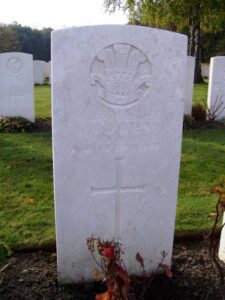
Thomas Davies, Private, 5750, Royal Welsh Fusiliers. Thomas was the son of Thomas and Mary Davies, of 17, Guest Cottages, Dowlais. He married Elizabeth Davies by 1891, when their first child Owen George Davies was born, and the family lived in 12, Burchell Row, Godrergraig. Thomas worked as a miner prior to enlisting into the Royal Welsh Fusiliers on 6 July 1898 and saw service during the Boer War of 1899-1902, being severely wounded at Rooidam on 5 May 1900. After recovering from his wounds Thomas continued to serve until joining the army reserve on 5 July 1910 and re-joined his family at Godrergraig. Within a year of leaving the army Thomas was jailed for ‘rioting, intimidation and assault’ at Llanguicke, and spent six months in Swansea Prison. He was called up at the outbreak of war and embarked for France on 20 October 1914, joining the 1st Battalion, Royal Welsh Fusiliers which had been at the front since landing at Zeebrugge on 7 October 1914, attached to 22 Brigade, 7th Division. The division was forced to withdraw from Zeebrugge, which was already falling to the Germans and marched via Bruges and Ostend before entraining for Ghent where the battalion covered the retirement of the Belgian and French armies before being forced into a fighting withdrawal to the ancient city of Ypres, becoming the first British division to hold the city. It got caught up in terrible fighting following the German assault on the city from 19 October 1914 onwards, during an epic and vital battle which became known as the First Battle of Ypres. Thomas was killed in action during one of the many German attacks on the thinly stretched defensive ring around Ypres, near Kleine Zillebeke, on 30 October 1914, aged 42. He has no known grave and is commemorated on panel 22 of the Ypres (Menin Gate) Memorial, Belgium.
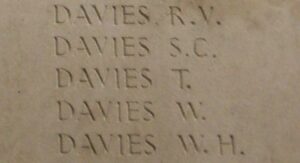
Frederick Albert Davis, Private, 45611, South Wales Borderers. Fred was from Bristol but had moved to Ystalyfera to serve an apprenticeship as a grocer with William Thomas, Pantteg. He married Fanny Counsell, the daughter of Mrs Counsell, of Canal Terrace, Ystalyfera in 1914 and the couple set up home at Kenfig Hill. Fred enlisted at Bridgend into the 12th Battalion, South Wales Borderers, which was attached to 119 Brigade, 40th (Bantam) Division, and landed in France on 2 June 1916 before taking up positions at Loos. Late in 1916 the division moved south to the Somme to take part in the Battle of the Ancre and remained in the area over the winter. In March 1917 the Germans withdrew to their shortened line, called the Hindenburg Line, and the 40th Division was one of the Divisions that followed the withdrawal. Later in the year it took part in the Battle of Cambrai, playing an important role in the attack on Bourlon Wood. Fred was killed in action during horrific conditions, fighting within Bourlon Wood on 25 November 1917, aged 27. He has no known grave and is commemorated on panel 5 of the Cambrai Memorial, Louverval, France. Fred does not appear to be commemorated locally.
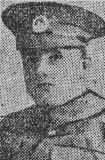
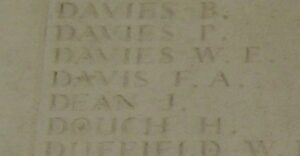
Ronald Guy Dawes, Private, 290694, Welsh Regiment. Ronald was the son of Archibald and Elizabeth Dawes, of Gough Building, Ystradgynlais. He enlisted into the Welsh Regiment and was posted to France, probably after the assault of the 38th (Welsh) Division on Pilckem Ridge on 31 July 1917, to join the 10th Battalion, Welsh Regiment, which was attached to 114 Brigade of the Division. He joined the division when it was still in the Ypres sector just prior to its move to the Armentieres sector where it spent the coming months. As a result of the emergency caused by the German’s Spring Offensive on the Somme, the 38th (Welsh) Division was transferred south, ordered to take up the line north of Albert, facing Bouzincourt Ridge. By now several of the battalions in the division had been disbanded and Ronald had been transferred to the 15th Battalion, Welsh Regiment (Carmarthen Pals), in the same Brigade. It held this sector before launching its offensive across the flooded valley of the River Ancre on 21 August 1918, with the 15th Welsh leading the way, and over the coming days captured the Thiepval Ridge. Ronald was killed during the assault on Common Lane, a trench between St. Pierre Divion and Pozieres, on 23 August 1918, aged 18. He has no known grave and is commemorated on panel 7 of the Vis-en-Artois Memorial, Haucourt, France.
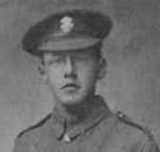
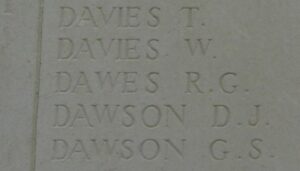
Phillip Draper, Private, 15526, Monmouthshire Regiment. Phillip was the illegitimate son of Mrs. Mary Jane Vellacott, of Church Lane, Ivybridge, Barnstaple, Devon. He lived at Dyffryn Clwyd, Ystalyfera prior to the war and worked as a bricklayer’s labourer. Phillip enlisted at Ystradgynlais into the South Wales Borderers and was posted to France at some time in 1916, joining the 2nd Battalion, Monmouthshire Regiment, which was the pioneer battalion to the 29th Division. The division had suffered terrible casualties following its assault against Y-Ravine on the opening day of the Somme offensive, on 1 July 1916 and was pulled from the line to rebuild. It moved back into the line in time to take part in the fighting around Le Transloy and Gueudecourt. The division wintered on the Somme and during most of December the 2nd Monmouths carried out vital work in the Montauban area, repairing roads and constructing a light railway from Guillemont to Combles. By the beginning of January, the division had moved out of the line to train, and the 2nd Monmouths carried out practise attacks as part of the divisional plan of training. By 12 January 1917 the 2nd Monmouths had begun to move back towards the Montauban area again, and on 18 January 1917 the battalion was at work improving trenches, shelters and dugouts around Plank Avenue when Phillip was killed by a shell which hit one of A Company’s shelters. The 21-year-old has no known grave and is commemorated on pier and face 4A on the Thiepval Memorial, France.
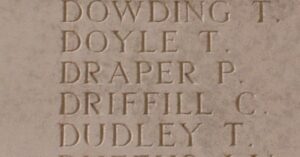
Edward George Dugay, Private, 74068, Welsh Regiment. Edward was born in Steep, Hampshire, the son of Henry and Sophia Dugay. By 1911 the family was living at 11, Maesycoed Road, Ynysmeudwy. Edward worked as a collier prior to enlisting at Cardiff into the Welsh Regiment on 20 April 1918 and landed in France on 21 September 1918, before being posted to the 14th Battalion, Welsh Regiment (Swansea Pals), which was attached to 114 Brigade, 38th (Welsh) Division and was taking part in the advance towards the mighty Hindenburg Line, which was broken on 29 September. Edward joined up with the battalion in the line on the Fins ridge on 30 September, in time to take part in an attack on the village of Malincourt on 8 October. The battalion then left the line to rest at Troisvilles before moving back into the line on 17 October in order to carry on the advance. By 29 October the 14th Welsh had taken over the line in front of Croix, and it was here that Edward was killed in action, on 31 October 1918, aged 21. He has no known grave and is commemorated on panel 7 of the Vis-en-Artois Memorial, Haucourt, France.
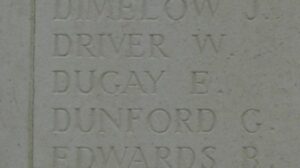
John Sidney Edwards, Guardsman, 675, Welsh Guards. John was the son of Thomas and Sarah Edwards, of Graig Stores, Pantteg, Ystalyfera. He worked at the Mardy Tinplate Works prior to becoming one of the first men from the Swansea area to enlist into the 1st Battalion, Welsh Guards. The Regiment was raised by Royal Warrant of 26 February 1915, at White City, before landing at Le Havre on 18 August 1915, becoming attached to 3rd Guards Brigade, Guards Division. The Division saw its first major action during the Battle of Loos on 25 September 1915, remaining in the area during the coming months, where they also fought in the subsequent Action of Hohenzollern Redoubt. In July 1916 the Division moved to the Somme, in order to take part in the great offensive, taking over a sector of the line named Bow Street, between Beaumont Hamel and Serre, on 11 August 1916. John was killed whilst on sentry duty here on 14 August 1916 when fragments from a bomb thrown by a member of a German trench raiding party caught him in the chest. He was 22 years old and is buried in plot 1, row F, grave 4 in Bertrancourt Military Cemetery, France.
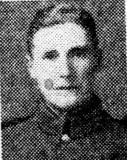
James Evans, Private, 34206, Welsh Regiment. James was born at Ystalyfera on 17 September 1892, the son of Thomas Evans and Sarah Evans (nee Williams). He married Annie Mary Jenkins on 18 June 1910 and the couple lived at 4 Canal Terrace, Ystalyfera. James worked as a collier prior to enlisting at Swansea into the 3rd Battalion, Welsh Regiment on 14 April 1915 and was posted to France on 13 July 1915, joining the 2nd Battalion, Welsh Regiment, which was attached to 3 Brigade, 1st Division. The division had seen heavy fighting since moving to France as part of the BEF in August 1914 and was at Vermelles preparing to take part in the forthcoming Battle of Loos. The division was attached to IV Corps which held the line from the Double Crassier to the Vermelles to Hulluch Road and was ordered to attack and capture the village of Hulluch, then to join up with the 15th Division before making a joint assault against the German second system between Hulluch and Cite St. Emilie. The battle, which began at dawn on 25 September 1915, proved disastrous for the British. The British had opened the assault with a cloud of poison gas which blew back upon our own troops and the 2nd Welsh suffered a large number of casualties during their advance. James was among a large number of men wounded and captured by the Germans during the Battle of Loos and was held at a Pow camp in Switzerland for the remainder of the war. He was released after the Armistice and was discharged from the army on 28 March 1919. James died at Ystalyfera on 10 September 1922, aged 30, most likely as a result of hardships suffered during his time in captivity, and was buried in Ystalyfera (Holy Trinity) Churchyard, Wales. He died too late to be commemorated as a war casualty by the CWGC.
William James Evans, Lance Corporal, 38479, Gloucestershire Regiment. William was the son of Ebenezer and Mary Ann Evans, of 30, Alltygrug Road, Ystalyfera. He worked as a draper in Swansea prior to enlisting at Cardiff into the South Wales Borderers, and was posted to France, joining the 8th Battalion, Gloucestershire Regiment, which was attached to 57 Brigade, 19th (Western) Division. The division took part in some of the most infamous battles of the war, after seeing its first action during the Battle of Loos on 25 September 1915, fighting throughout the Somme offensive in 1916 and at Messines and Ypres in 1917. During the early months of 1918 the division was unluckily caught up in the three major German offensives of the war before being rebuilt and took part in the 100 days offensive. By 22 October 1918 the division was facing the German positions across the River Selle, near Haussy, and 57 Brigade was ordered to attack the following day, with the 8th Gloucesters in the front, and capture the village of Les Fourrieres and consolidate the high ground near St. Martin’s Chapel. William was killed in action during the battalions assault that day, on 23 October 1918, aged 20. He is buried in grave VI.E.8. in Romeries Communal Cemetery Extension, France. There is some confusion over the date of his death. The CWGC records it as 22 October 1918, whilst SDGW shows 23 October 1916. His soldiers’ effects papers state 23 October 1918, while his battalion did not attack until 23 October 1918, so he must have been killed on that date.
George Walter Faulkner, Lance Corporal, 21074, Royal Welsh Fusiliers. George was born in Bow, London, the son of George and Elizabeth Faulkner. The family had moved to 3, Midland Terrace, Gurnos prior to 1891, after George’s father had gained work at the Tarreni Colliery. George himself worked at a munitions works prior to enlisting into the 17th Battalion, Royal Welsh Fusiliers. George did not embark for France with the battalion, which was attached to 113 Brigade, 38th (Welsh) Division, but joined it in France in 1916. He possibly joined the battalion after the division had been withdrawn from the Somme following its assault at Mametz Wood and had moved to Ypres to rebuild. Here it fought at the Battle of Pilckem Ridge, and the Battle of Langemarck. The division then moved to Armentieres, where it remained from September 1917 until March 1918 when the German Spring Offensive was launched. The British had been over-run on the Somme, and so in April the Division was moved South, taking up positions North of Albert, facing Bouzincourt Ridge. George was one of two men from the battalion killed whilst it was at work improving bivouacs on the ridge south-east of the village of Senlis on 13 April 1918. The 31-year-old is buried in grave F.19. in Hedauville Communal Cemetery Extension, France.
Harry Bickerdike Furness, Private, 17775, Welsh Regiment. Harry was born in Farnley, Yorkshire in 1889, the son of James Russel Furness and Mary Jane Furness. Following the death of his father in 1891, his mother married John William Givens and the family lived in 22, Nutting Road, Farnley. The family moved to Cwmtwrch prior to the war and lived at Mount Pleasant, Gurnos. Harry enlisted at Swansea into the 14th Battalion, Welsh Regiment (Swansea Pals) soon after the outbreak of war. The battalion trained at Rhyl before moving to Winchester as part of 114 Brigade, 38th (Welsh) Division and landed in France on 2 December 1915. The division was initiated into the arts of trench warfare in the Fleurbaix sector, before holding the line itself at Cuinchy, and near Neuve Chapelle before being moved to the Somme in June 1916. On 7 July 1916 115 Brigade of the division made a frontal assault on Mametz Wood but were repulsed with heavy losses, and three days later, on 10 July 1916, the attack was renewed. Harry was killed in action during the horrific fighting within the wood that day. The 28-year-old has no known grave and is commemorated on pier and face 7A and 10A of the Thiepval Memorial, France. His step-brother, William Sherlock Givens was taken prisoner by the Germans after being captured at Mametz Wood, while his step-father, John William Givens also served before succumbing to ill health in 1918.
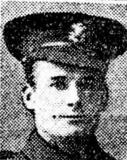
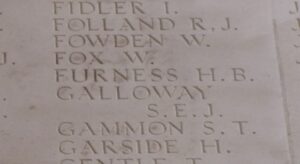
George Gardiner, Driver, T/13939, Royal Army Service Corps. George was the son of William and Elizabeth Gardiner, of Canon Pyon, Herefordshire. He married Catherine Lewis, of Gwyn Street, Alltwen, Pontardawe, in 1908, and the couple had four children. He worked as a coal miner prior to enlisting at Pontardawe into the Army Service Corps and was posted to France on 23 June 1915. George served in France until becoming ill in the late summer of 1917 and was brought back to Britain before being sent to the Military Hospital in Belfast for treatment. He died of sickness there on 27 December 1917, aged 32. His body was brought home to Alltwen, and he was given a burial with full military honours in Alltwen Welsh Congregational Chapelyard.
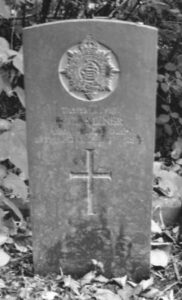
David George, Private, 235395, Royal Welsh Fusiliers. David was the son of William and Anne George, of Pantteg, Ystalyfera. He married Mary Hannah James in 1909 and the couple lived at 5, Harris Row, Godrergraig. He enlisted at Pontardawe on 7 October 1914 into the Brecknock Battalion, South Wales Borderers, and was posted to France almost two years later, landing at Rouen on 18 June 1917, originally bound to join the 4th Battalion, Royal Welsh Fusiliers. He was instead posted to the 14th Battalion, Royal Welsh Fusiliers on 8 July 1917, joining the battalion at Ypres, where it was attached to 113 Brigade, 38th (Welsh) Division, and was preparing to launch its assault on the Pilckem Ridge. The assault was launched from the divisions positions along the canal banks at Boesinghe at dawn on 31 July 1917 and the Welshmen attained their objectives with heavy losses. Further pushes forwards were made over the coming days in heavy rain and the battlefield soon turned into a mud bath. David was killed in action on 4 August 1917 just prior to the battalion being relieved and moving back to Elverdinghe Chateau. He was 31 years old and is buried in grave III.B.3. in Artillery Wood Cemetery, Belgium.
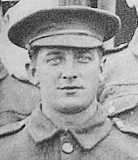
John Griffiths, Private, 15217, Welsh Regiment. John was the son of John and Mary Griffiths, of Rehoboth, Cwm-Coy, Newcastle Emlyn. He lived at Swanfield, Ystalyfera prior to the war, where he ran the Ystalyfera Stores and married Beatrice May Evans in 1916. John enlisted at Cardiff into the Monmouth Regiment, but later transferred to the 1/6th Battalion, Welsh Regiment, which was the Pioneer Battalion to the 1st Division. He joined the battalion at some time in 1916, probably prior to its march south from the Loos sector to the Somme in July 1916. The division saw heavy fighting at Munster Alley alongside the Australians during the Battle of Pozieres and fought throughout the Somme offensive from then onwards. The 6th Welsh carried out a lot of important work around Baizieux and Fricourt Wood throughout August and September 1916, under very trying conditions. From 20 September work began on road repairs and construction of communication trenches near Bazentin, and it was whilst carrying out this work that John was wounded in the head and stomach by shell shrapnel on 26 September. He died of his wounds two days later, on 28 September 1916 aged 36, and is buried in grave III.B.5. in Dernancourt Communal Cemetery Extension, France. Beatrice later resided at 17, Corbett Street, Ogmore Vale.
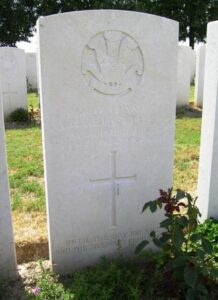
John Reynolds Griffiths, Aircraftman 2nd Class, 147139, Royal Air Force. John was the son of William and Kate Esther Griffiths, of 69, Wern Road, Ystalyfera. He had served with the Royal Welsh Fusiliers during the war and had taken part in the Third Battle of Ypres, before volunteering to serve with the Royal Air Force. John survived the war but took ill whilst stationed near London with the RAF and died of influenza at the 2nd London General Hospital, Chelsea on 10 February 1919, aged 23. His remains were conveyed home by train from Paddington Station and he was buried in Holy Trinity Churchyard, Godrergraig, to the south-west of the Church.
Rhys Griffiths, Private, 11463, South Wales Borderers. Rhys was the son of Richard and Mary Griffiths, of Cambrian View, Godrergraig. He enlisted at Brecon into the 1st Battalion, South Wales Borderers soon after the outbreak of war and was posted to France on 26 January 1915, joining the depleted battalion in Flanders, where it was attached to 3 Brigade, 1st Division. He probably served with the battalion at Neuve Chapelle and Loos before transferring to the 2nd Battalion, South Wales Borderers, which arrived in France in May 1916 attached to 87 Brigade, 29th Division. The division suffered heavy losses on the opening day of the Somme offensive on 1 July 1916 and rebuilt before taking part in the latter stages of the battle. During the following year it took part in the Battle of Arras and then took part in the Third Battle of Ypres. The division was still in the Passchendaele sector when the Germans launched their offensive on the Somme on 21 March 1918 and moved to Poperinghe before transferring to a new sector of the line to the south near Estaires. Unfortunately, the Germans launched their second offensive on 11 April 1918 in this sector and at dawn that day the division came under attack. Under heavy pressure the division was forced into a fighting withdrawal, but not before suffering terrible casualties. Rhys was killed in action at some time during that day, on 11 April 1918, aged 21. He has no known grave and is commemorated on panel 5 of the Ploegsteert Memorial, Belgium.
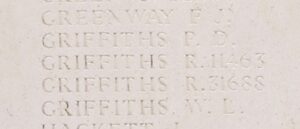
Henry Grove, Pioneer, 260534, Royal Engineers. Henry was the son of Wilson and Eliza Grove, of Evesham, Worcestershire. He married Fanny Moyle at Evesham in 1894 and by 1905 the family had moved to 64, Pentalwn, Godrergraig, after Henry had gained work at the Tarreni Colliery. He enlisted at Swansea into the Royal Engineers and was posted to France, joining the 338th Road Construction Company, Royal Engineers. Henry was killed in action whilst at work south of Arras on 8 June 1917, aged 45. He is buried in grave I.K.15. in Bucquoy Road Cemetery, Ficheux, France.
John Harries, Private, 42530, Lancashire Fusiliers. John was the son of David and Margaret Harries, of 44, Knoll Road, Godrergraig. He enlisted at Swansea into the Welsh Regiment, and was posted to France, joining the 2nd Battalion, Lancashire Fusiliers, which was attached to 12 Brigade, 4th Division. He probably fought with the battalion on the Somme in the summer of 1916 and in April 1917 the division took part in the Battle of Arras. Later that year the division was moved north and took part in the Third Battle of Ypres. On 9 October 1917 the battalion was in the front line at Ypres, ordered to launch an assault on a German position near Poelcapelle. The attack was largely a success, with a gain of some 600 yards on the right flank of the attack, and the battalion dug in and consolidated their newly gained positions. John was among around 200 casualties suffered by the battalion during the fighting that day, being killed in action on 9 October 1917, aged 19. He has no known grave and is commemorated on panel 54 to 60 of the Tyne Cot Memorial, Belgium.
William Thomas Henwood, Guardsman, 886, Welsh Guards. William was the son of William and Eleanor Henwood, of Alltygrug Road, Ystalyfera. He enlisted at Ystalyfera into the 1st Battalion, Welsh Guards. The Regiment was raised by Royal Warrant of 26 February 1915, at White City, before landing at Le Havre on 18 August 1915, becoming attached to 3rd Guards Brigade, Guards Division. William came home on leave with three other local men just before departing for the front. The Division saw its first major action during the Battle of Loos, which began on 25 September 1915, moving forwards towards the front on 26 September in order to assault the vital position of Hill 70. The Welsh Guards were in position by the evening and the attack began on the following evening, 27 September 1915. The guardsmen were mown down by concentrated machine-gun fire and were forced to withdraw after suffering terrible losses. William was killed that night, on 27 September 1915, aged 17. He has no known grave and is commemorated on panel 10 of the Loos Memorial, France.
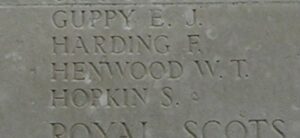
Lewis Holt, Private, 17809, Welsh Regiment. Lewis was born in Garnant, the son of John and Mary Jane Holt. After his father’s death his mother moved the family to Oakfield, Lower Cwmtwrch, Swansea. Lewis enlisted at Ystalyfera into the 14th Battalion, Welsh regiment, attached to 114 Brigade, 38th (Welsh) Division. The Division had landed in France during December 1915 and had spent their first winter in the trenches near Armentieres. In June they marched south to the Somme, where they were tasked with the capture of Mametz Wood. The attack on the wood began on 7 July, but met with fierce resistance, and it took until 11 July to clear the wood. Lewis was wounded in the chest during one of the attacks and was found lying on the battlefield by Captain Arthur Smith on 11 July. He was carried away by stretcher and brought to the Casualty Clearing Station at Heilly for treatment. He died of wounds there on 24 July 1916, aged 22, and is buried in grave II.C.55. in Heilly Station Cemetery, Méricourt-l’Abbé, France.
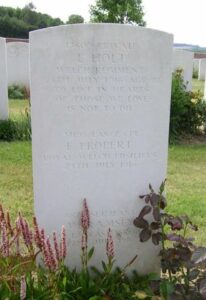
William Howells. William cannot presently be identified, but was possibly William David Howells, of Ynysmeudwy, who died in 1921, aged 25.
David Hughes, Private, 14762, South Wales Borderers. David was the son of John and Margaret Hughes, of Kidwelly. He married Mary Emily Musk at Seven Sisters in 1907, and the couple lived at 20, Bryndulais Row, Seven Sisters. David worked at the Yniscedwen Tinplate Works at Ystalyfera prior to the war, and enlisted at Ystradgynlais into the 2nd Battalion, South Wales Borderers. The battalion had begun their war in China, where they captured the German Garrison at Tientsin. The Battalion returned to England where they joined 87 Brigade, 29th Division. The Division moved to Gallipoli via Egypt, landing on 25 April 1915. They remained here until evacuation to Egypt on 11 January 1916, and then moved to the Western Front on 15 March 1916. David was killed in action soon after, during the battalions first spell in the trenches, on 6 April 1916, aged 30. He is buried in grave F.6. in Mesnil Ridge Cemetery, Mesnil Martinsart, France. Two of his brothers also fell; Sam and Willie Hughes, and all three are commemorated on the Kidwelly War Memorial.
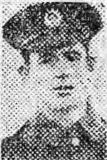
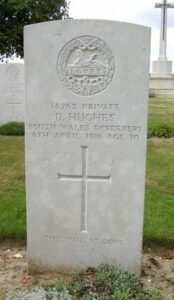
Tom Hughes. See Tom Williams.
Joseph James, Corporal, 17116, Royal Warwickshire Regiment. Joseph was the son of John Llewelyn James and Sarah James, of Hodgson Row, Ystalyfera. He enlisted at Parkhurst, Isle of Wight, into the army and was posted to the 14th Battalion, Royal Warwickshire Regiment. The battalion had landed in France on 21 November 1915 with the 32nd Division before being transferred to 13 Brigade, 5th Division and in March 1916 moved to positions between St. Laurent-Blangy and Vimy, near Arras. On 1 July 1916 the Battle of the Somme opened, and the Division moved south, to take part in the fighting at High Wood, Guillemont, Flers-Courcelette, Morval and Le Transloy. On 5 October, after suffering heavy casualties, the Division moved to Festubert, where it remained until March 1917. It next saw action at the Battle of Arras, fighting at the Battle of Vimy in April 1917, and the attack on La Coulette. On 3 May it fought in the Third Battle of the Scarpe. The trenches the battalion took over on this day were found to be full of dead, so new trenches were hurriedly dug, in order to utilise them to attack Oppy Wood and village and over the coming days took part in terrible fighting. Joseph was killed at Oppy Wood on 7 May 1917, aged 22. He is buried in grave IX.A.37. in Orchard Dump Cemetery, Arleux-en-Gohelle, France.

Arthur Meredith Jenkins, Private, 81462, Durham Light Infantry. Arthur was born at Lledrog Farm, Ambleston, Pembrokeshire in 1899, the son of Arthur and Elizabeth Jenkins. By around 1910 the family moved to Gilfach y Rhaidd Farm, Ystalyfera. Arthur had worked as a miner, before enlisting into the Lancashire Fusiliers on 8 November 1917. He embarked for France at Folkestone on 31 March 1918, and upon arrival at Étaples, was posted to the 22nd Battalion, Durham Light Infantry, which was the Pioneer battalion to the 8th Division. The division was hit hard by the German Somme offensive which had been launched on 21 March 1918 and was moved south to the Aisne sector to rebuild. It was hit again here during the German Aisne offensive, and suffered heavy casualties. Arthur was killed in action there on 28 May 1918, aged 18. He is buried in grave II.E.7. in Hermonville Military Cemetery, near Rheims, France.
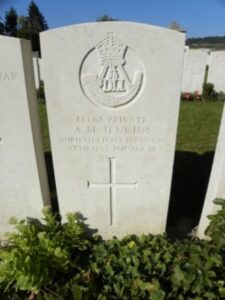
Benjamin Jones, Private, TR/5/14068, Training Reserve. Benjamin was born in Cwmtwrch in 1886, the son of David Benjamin Jones and Elizabeth Jones. The family was living in 21 Carol Terrace, Ystalyfera by 1911. Benjamin worked as a collier prior to enlisting at Cardiff into the army and was posted to the 84th Battalion, Training Reserve, before being posted to the 29th Battalion, Northumberland Fusiliers. He does not appear to have served overseas, but died at Clipstone Camp on 6 July 1918, aged 32. He is buried in grave U.S.664. in Caerphilly (Penyrheol) Cemetery, Wales. His brother David also fell.
David John Jones, Private, 27778, South Wales Borderers. David was the son of David Benjamin Jones and Elizabeth Jones, of 21, Carol Terrace, Ystalyfera. He worked as a collier prior to enlisting at Brecon into the Brecknock Battalion, South Wales Borderers and landed in Persia on 3 July 1915. He probably took part in the operations at Aden with the battalion before transferring to the 6th Battalion, Devonshire Regiment, which was in Mesopotamia, and later transferred to the 4th Battalion, South Wales Borderers, which was attached to 40 Brigade, 13th (Western) Division. The division had been part of a large force built up to attempt to break the siege of Kut but ended up taking part in a drawn out and unpleasant war. David died in Mesopotamia on 14 November 1917, aged 24. He has no known grave and is commemorated on panel 16 or 62 of the Basra Memorial, Iraq. His brother Benjamin also fell.
Handel Jones, Private, 56866, Welsh Regiment. Handel was the son of Thomas and Mary Jane Jones, of 11 Glyn Road Brynamman. He was educated at Ystalyfera County School before working as a printer. Handel enlisted into the Pembroke Yeomanry on 12 December 1915, and after training was posted to the 13th Battalion, Welsh Regiment (2nd Rhondda), which trained at Rhyl and Winchester as part of 114 Brigade, 38th (Welsh) Division. Handel served in France with the division, but was gassed at some time and sent home, where he was discharged as medically unfit on 23 September 1918. He died at home at Brynamman on 19 November 1919, aged 26 and his remains were brought to Ystalyfera to be buried in Ystalyfera (Holy Trinity) Churchyard.
Rees Jones, Private, 203373, Machine Gun Corps. Rees was born in Cellan, Ceredigion, the son of Daniel and Mary Jones. By 1901 the family had moved to Caedu Isaf, Llanguicke, before settling at Pant Farm, Rhiwfawr, Lower Cwmtwrch. Rees worked as a collier before enlisting at Gwaun-Cae-Gurwen into the 4th Battalion, Welsh Regiment. He was posted to Salonika, joining the 11th Battalion, Welsh Regiment, which was attached to 67 Brigade, 28th Division, but was then posted to the 67th Battalion Machine Gun Corps, due to being a specialist machine-gunner. Rees was killed in action during the Battle of Doiran on 6 October 1918, aged 32, and is buried in grave 528 in Mikra British Cemetery, Kalamaria.
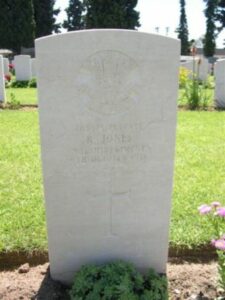
Thomas Jones, Private, 27776, South Wales Borderers. Thomas was the son of Daniel and Mary Ann Jones, of Canal Terrace, Ystalyfera. He lived with his wife Annie Jones and their one child at 23, Canal Terrace, Ystalyfera. Thomas enlisted at Ystalyfera into the Brecknock Battalion, South Wales Borderers and was posted to Mesopotamia, firstly joining the 6th Battalion, Devonshire Regiment before being posted to the 4th Battalion, South Wales Borderers, which was attached to 40 Brigade, 13th (Western) Division. The division had been sent to Mesopotamia following service in Gallipoli as part of a force which had been assembled to attempt to relieve the besieged garrison at Kut. After a difficult campaign the division finally captured the city of Baghdad by 11 April 1917, the 4th SWB becoming the first troops to enter the city. Thomas was killed in action during the consolidation of the ground near the River Adhaim on 30 April 1917, aged 25. He has no known grave and is commemorated on panel 16 or 62 of the Basra Memorial, Iraq.
William Jones, Private, 44971, South Wales Borderers. William was the son of Rees and Ann Jones, of 25, Brick Row, Ystalyfera and the husband of Margaret Ann Jones. He enlisted at Ystradgynlais into the Brecknock Battalion, South Wales Borderers and embarked for Aden to join the battalion, arriving on 3 July 1915. The battalion was moved to India soon afterwards and William was posted to the 7th Battalion, South Wales Borderers, which was in Salonika attached to 67 Brigade, 22nd Division. He was then transferred to 150 Squadron, Royal Air Force following the formation of the RAF in April 1918 due to the merging of the RFC and RNAS and equipped with Bristol M.1c, Royal Aircraft Factory SE.5a, and Sopwith Camel aircraft. William died in Salonika on 21 November 1918, aged 40, and is buried in grave 915 in Mikra British Cemetery, Kalamaria, Greece.
John Walker Keen, Private, 17273, Welsh Regiment. John was born in Hackney on 31 May 1875, the son of Alfred Keen. He married Delina Lane in St. Saviour’s Church, Hoxton on 21 May 1894 and had served with the London Territorials, Royal Engineers around the turn of the century, seeing service in the Boer War. John and Delina moved to 18, Ynisdarren Road, Ystalyfera prior to 1905 and John worked as a painter. He enlisted at Swansea on 5 October 1914 into the 14th Battalion, Welsh Regiment (Swansea Pals), which trained at Rhyl and Winchester before landing in France on 2 December 1915 attached to 114 Brigade, 38th (Welsh) Division. Within weeks John had been promoted to Sergeant, but only held the rank for a month before being reduced to Private through being found drunk on duty. He took part in the divisions assault on Mametz Wood in July 1916 but by January 1917 had been transferred to the Depot at Cardiff after his health had begun to fail. On 25 February 1917 John was discharged from the army as medically unfit after being diagnosed as suffering from heart disease and he died at home at Ystalyfera on 26 December 1917, aged 42. His wife, Delina had left him sat by the fire and returned home to find him dead in the chair. John was buried in St. David’s Church Burial Ground at Ystalyfera. He is not presently commemorated by the CWGC, but I have recently sent evidence off to the CWGC to attempt to get him commemorated as a war casualty.
Harold Idris King, Private, 27780, South Wales Borderers. Harold was the son of Thomas and Caroline King, of Hazelhurst, Lower Cwmtwrch. He was a schoolteacher prior to the war and enlisted at Ystradgynlais into the Brecknock Battalion, South Wales Borderers. He embarked for overseas service in Aden with the Brecknocks, and afterwards transferred to the Devonshire Regiment, before being transferred to the 4th Battalion, South Wales Borderers. The battalion was attached to 40 Brigade, 13th (Western) Division in Mesopotamia. Harold was wounded during General Maude’s offensive towards the besieged city of Kut, in Mesopotamia. He died of his wounds on 19 February 1917, aged 21. Harold has no known grave and is commemorated on panel 16 and 62 of the Basra Memorial, Iraq.
Llewellyn Tibbett Lewis, Private, 58340, Welsh Regiment. Llewellyn was the son of Edward and Hannah Lewis, of 6, Susanah Street, Cwmtwrch. He worked as a collier and was living at Castle Street, Lower Cwmtwrch when he enlisted at Brecon into the 3rd Battalion, South Wales Borderers on 24 April 1918. On 3 August 1918 he embarked for France to join the 5th Battalion, South Wales Borderers, but was instead transferred to the 13th Battalion, Welsh Regiment (2nd Rhondda), which was attached to 114 Brigade, 38th (Welsh) Division. Llewellyn joined up with his new battalion during the advance of the 38th (Welsh) Division across the old Somme battlefields, which had been launched on 21 August 1918. The battalion helped capture Pozieres and Thiepval Ridge over the coming days before taking part in the 100 days offensive which took them past Mametz Wood and Delville Wood, before capturing Morval and Sailly-Saillisel. By 17 September the division had reached positions in front of the strongly defended village of Gouzeaucourt, which it had orders to assault and capture. At dawn on 18 September 1918 the division launched its assault, and the 13th Welsh attacked African and Heather Trenches. Heavy fighting continued over the coming days, but Llewellyn did not live to see the successful outcome of the attack, being killed in action on the first day. The 21-year-old has no known grave and is commemorated on the Vis-en-Artois Memorial, Haucourt, France.
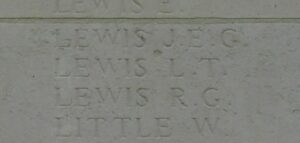
Albert Victor Lloyd, Corporal, 27677, Machine Gun Corps. Albert was the son of Josiah and Mary Lloyd, of 42 Stokes Croft, Christ Church Street East, Frome, Somerset. He lived at Ystalyfera prior to the war where he worked on the staff of the local newspaper, Llais Llafur. Albert enlisted at Swansea into the Somerset Light Infantry in December 1915 and initially trained at Plymouth before being sent to Grantham to train as a machine-gunner. He was drafted to France with the 124th Company, Machine Gun Corps, which was formed in May 1916 attached to the 41st Division. The Division moved to the Ploegsteert sector and the Douve valley, south of Ypres for trench initiation. It remained here until August 1916, when it moved to the Somme, and took part in the Battle of Flers-Courcelette. The Division remained in the line, pushing on to Courcelette over the next few days before coming out for a rest and re-fit. It then fought at the Battle of Le Transloy, before moving to positions south of Ypres in 1917. During the spring of 1917 Albert was invalided home after falling ill, but soon re-joined his unit in Belgium. He took part in the divisions attack during the Battle of Messines, and during its later actions during the Battle of Pilckem, and the Battle of the Menin Road, as part of the Third Battle of Ypres. Albert was killed in action at Ypres on 20 September 1917, aged 21. He has no known grave and is commemorated on panel 154 to 159 and 163A of the Tyne Cot Memorial, Belgium.
William Lock, Lance Corporal, 146073, Royal Engineers. William was born on 20 June 1895, the son of Joseph and Caroline Lock, of Hillfarrance, Somerset. He came to live at 3, Gnoll Road, Godrergraig prior to the war after gaining work as a collier. He enlisted at Ystradgynlais on 16 October 1914 into the Brecknock Battalion, South Wales Borderers but was discharged on 24 January 1916 in order to transfer to the Royal Engineers. William was posted to France on 12 February 1916, joining the 252nd Tunnelling Company, Royal Engineers, which was by then working on deep mines and dugouts in the Somme sector. The famous Hawthorne Mine which was filmed exploding on 1 July 1916 was dug by the company. William survived the Somme offensive, but was killed in action on 20 November 1917 when his unit was working near the Hindenburg Line sector. The 23-year-old has no known grave and is commemorated on panel 1 and 2 of the Cambrai Memorial, Louverval, France.
Patrick Maher, Private, 13291, South Wales Borderers. Patrick was from St. Finbarr’s, Cork. He married Martha Richards in 1911 and the couple lived at 22, Owen’s Lane, Godrergraig. He enlisted at Ystradgynlais into the 4th Battalion, South Wales Borderers and served at Gallipoli with the battalion after landing on 19 July 1915. Patrick must have been wounded or taken ill and invalided home as he transferred to the 1st Battalion, South Wales Borderers, which was in France attached to 3 Brigade, 1st Division. The division marched south from Loos to the Somme sector in July 1916 in order to take part in the Somme offensive, and fought alongside the Australians during the Battle of Pozieres, seeing heavy fighting at Munster Alley. Patrick was shot dead by a sniper while his battalion was in the trenches on 25 September 1916, aged 31. He has no known grave and is commemorated on pier and face 4A of the Thiepval Memorial, France.
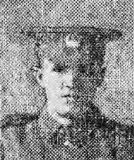
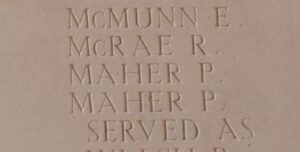
Joseph Henry Marshall, Private, 18264, South Wales Borderers. Joseph was the son of George and Mary Anne Marshall, of Newcastle-under-Lyne, Staffordshire. By 1911 he was working at Ystalyfera and lodged at Church Road, Godrergraig. He enlisted at Ystradgynlais into the 5th Battalion, South Wales Borderers, which was attached to 58 Brigade, 19th (Western) Division and landed in France with the battalion on 17 July 1915. The Division took part in the opening attack of the Battle of Loos on 25 September 1915, suffering heavy casualties for no gain. The following year the Division moved to the Somme, where it took part in the second wave of the attack on Ovillers-La Boisselle on 1 July, capturing the village at heavy cost. It then fought through the Somme Battles of Pozieres and the Ancre in 1916. The division wintered on the Somme, and the 5th SWB carried out a lot of work in the Hébuterne area, tunnelling and digging trenches and mine shafts. On 28 January 1917 the battalion was at work constructing an ammunition dump and a tramway in Hébuterne when Joseph was reported to have died of natural causes due to the terrible weather conditions. He was 32 years old and is buried in grave II.J.10. in Sailly-Au-Bois Military Cemetery, France.
Thomas Robert Martin, Private, 238146, King’s Own Yorkshire Light Infantry. Thomas was the son of John Isaac Martin and Jane Martin, of Hereford Villa, Glanrhyd, Ystradgynlais. He enlisted into the Brecknock Battalion, South Wales Borderers and married Alice Llewellyn, of Green House, Marloes, Pembrokeshire in 1917, just prior to embarking for France. Thomas was posted to the 5th Battalion, King’s Own Yorkshire Light Infantry, which was attached to 187 Brigade, 62nd (2nd West Riding) Division. On 5 January 1918, the Division took over the front line in the Arras area, between Gavrelle and Oppy, and following the German offensive of 21 March 1918 became caught up in heavy fighting, distinguishing itself by holding off five attacks by regiments of the Prussian Guard on 26 March. The remnants of the Division were relieved on 31 March to rebuild, but following another German offensive on the Aisne, the division was sent south to assist, taking part in more heavy fighting. The division was then moved back north and from 21 August 1918 onwards took part in the great 100 days offensive which ultimately won the war. Thomas was shot in the back during the early stages of the great advance and was invalided home to a military hospital in Surrey, where he died of his wounds on 29 September 1918, aged 23. His remains were brought back home for burial in Holy Trinity Churchyard, Godrergraig., to the north of the Church, near the north-west boundary.
Andrew Mason, Private, 27787, South Wales Borderers. Andrew was the son of Thomas and Grace Mason, of Greengairs, Lanarkshire. His father died in 1897, and his mother married Thomas Campbell, who moved the family to Church Road, Godrergraig, where Andrew was raised as Andrew Campbell. He enlisted locally into the Brecknock Battalion, South Wales Borderers, and was posted to Aden on 3 July 1915. Following the transfer of the Brecknocks to India, Andrew was posted to the 6th Battalion, Devonshire Regiment in Mesopotamia, before being posted to the 4th Battalion, South Wales Borderers. The battalion was attached to 40 Brigade, 13th (Western) Division and had been sent to Mesopotamia as part of a large force in order to relieve the besieges garrison at Kut. Following the surrender of Kut, the British took part in an unpleasant campaign in the arid country. Andrew died whilst a prisoner of war of the Turks on 1 January 1918 aged 25. He has no known grave and is commemorated on panel 16 or 62 of the Basra Memorial, Iraq.
Daniel John Morris, Driver, T4/109189, Royal Army Service Corps. Daniel was the son of Benjamin and Mary Ann Morris, of Aberdare. He enlisted into the Royal Monmouth Royal Engineers on 22 April 1913 and was discharged due to misconduct on 26 December 1914. He had married Mary Frances Hayes on 30 March 1914 and the couple lived at 2, Roderick Villas, Penrhos, Ystradgynlais, where their son William Daniel Morris was born. On 27 May 1915 he re-enlisted into the Welsh Division Army Service Corps and served with the 38th Divisional Train until going absent and was spent several months in detention. He was then transferred to the 334th Company, ASC before being attached to the 1st South African Field Ambulance. Daniel served in the Mediterranean from 28 December 1915 until 17 February 1916 when he returned home after falling ill, due to a urethral abscess and after recovering was posted to the 54th Divisional Train. Daniel was at Salisbury when he was rushed to hospital and died at Fargo Military Hospital, Salisbury Plain of a ruptured bowel on 3 June 1916, aged 23. A newspaper report was published in the Salisbury Times soon afterwards which stated that Daniel had been hurt during a fight with some other soldiers whilst drunk on 28 June and was rushed to hospital after falling ill the next morning. A court of enquiry was later held which came to the conclusion that as his death was not caused by his military service, but was his own fault, that his widow was denied her pension. Daniel is buried in the Catholic ground, grave V.I.6. in Aberdare Cemetery, Glamorgan.
John Murphy, Lance Corporal, 3065, Welsh Guards. John was the son of Morris and Mary Ann Murphy, of 107, Clifton Hill, Ystalyfera. He worked as a tinplate roller at the Ystalyfera Tinplate Works prior to enlisting at Cardiff into the Welsh Guards and was posted to France late in 1916, to join the 1st Battalion, Welsh Guards, which was attached to the 3rd Guards Brigade, Guards Division. John fought with the Welsh Guards at the Battle of Pilckem Ridge and also at Cambrai later in 1917, where he was gassed. After recovering he was promoted to Lance Corporal, on account of him having taken out a problematic German sniper. He took part in heavy fighting with the Guards following the launching of the German spring offensive on 21 March 1918, when the Guards were forced to carry out a fighting withdrawal towards Arras. The division took part in the great 100 days offensive, which was launched on 21 August 1918, and played a part in driving the Germans back towards the Hindenburg Line and beyond. John was killed during heavy fighting around St. Vaast on 11 October 1918, aged 23. He is buried in grave A.2A. in St. Vaast Communal Cemetery Extension, France.
Thomas O’Connor, Private, 5347, Irish Guards. Thomas was from Tralee, Co Kerry. He lived at Ystalyfera prior to the war, and married Catherine Bowen, of Lower Cwmtwrch, in the summer of 1910. Thomas had served as a Policeman at Ystalyfera under Sergeant Bowen, for several years prior to leaving the force to work at the Phoenix Tinplate Works. He enlisted into the Irish Guards soon after the outbreak of war and on 23 November 1914 was posted to France, joining the 1st Battalion, Irish Guards, which was attached to the 4th (Guards) Brigade, 2nd Division. The battalion had suffered heavily during the early months of the war, especially during the defence of Klein Zillebeke. In May 1915, the 1st Irish Guards took part in the Battle of Festubert, and on 20 August 1915 transferred to the 1st Guards Brigade, Guards Division, taking part in the Battle of Loos in September 1915. After wintering in the Ypres Salient, the division left for the Somme on 27 July 1916 in order to take part in the Somme offensive and saw heavy fighting at Ginchy, Flers-Courcelette and at Morval. The Guards Division remained in the Somme sector over the winter of 1916-17 and followed the German withdrawal to the Hindenburg Line the following year, before being transferred back to the Ypres Salient, taking the line north of the 38th (Welsh) Division along the Yser Canal. On 28 June 1917 the battalion was in the trenches near Boesinghe, when Thomas became wounded. He was walking back to the dressing station when he was struck by a shell fragment which killed him. The 37-year-old is buried in grave 3.F.24. in Ferme Olivier Cemetery, Ieper, Belgium.
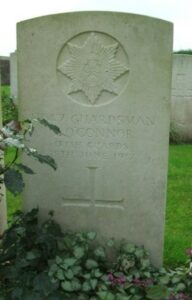
Patrick O’Leary, Private, 21466, Lancashire Fusiliers. Patrick was born in Rawalpindi, India, the son of Michael and Ellen O’Leary. The family later returned to Kilmanor, Ireland. He lived with his wife, Bridget O’Leary, at Railway Terrace, Ystalyfera prior to the war. He enlisted at Wigan into the 1st Battalion, Lancashire Fusiliers, and joined the battalion at Gallipoli on 9 September 1915, where it was attached to 87 Brigade, 29th Division. The division was evacuated to Egypt in January 1916 before embarking for the Western Front in March 1916, taking up positions facing Beaumont Hamel, on the Somme. Patrick was mentioned in the battalion war diary for his coolness under fire during a German trench raid during May 1916. Patrick was killed during a retaliatory trench raid made against the Germans on 28 June 1916, aged 40. He is buried in grave II.B.17. in Auchonvillers Military Cemetery, France. Just three days later the division was decimated attacking Y-Ravine during the opening of the Somme offensive.
William Penhale, Private, 12292, South Wales Borderers. William was the son of Humphrey and Martha Penhale, of Ystalyfera. He lived with his uncle John and his aunt Emily Penhale, of Commercial Street, Ystalyfera prior to the war. He worked as a labourer prior to enlisting into the 1st Battalion, South Wales Borderers at Brecon. William was posted to France on 8 May 1915 joining the battalion near Loos, where it was preparing to take part in the forthcoming Battle of Loos. On the following year he was transferred to the 2nd Battalion, South Wales Borderers which had arrived on the Western Front in March 1916 following service at Gallipoli attached to 87 Brigade, 29th Division. The division took up the line opposite Beaumont Hamel, facing Y-Ravine which it assaulted at dawn on 1 July 1916 during the opening of the Somme offensive. William was among hundreds of men mown down by concentrated machine-gun fire during the divisions assault that morning. He was 35 years old and is commemorated on pier and face 4A of the Thiepval Memorial, France.
Harry Lucas Hillier Perrett, Sergeant, 5279, Coldstream Guards. Harry was the son of Hannah Perrett, of Rowde, Wiltshire. He had served for several years with the Coldstream Guards, but had left to work for the Great Western Railway as a canal labourer at Ystalyfera prior to the war. He re-enlisted into the Coldstream Guards at the outbreak of war and landed in France on 12 August 1914 with the 3rd Battalion, Coldstream Guards, which was attached to the 4th (Guards) Brigade, 2nd Division. He took part in the epic retreat of the BEF from Mons to the Marne, and in the ensuing Battles of the Marne and Aisne, before the BEF moved to Flanders and fought at the First Battle of Ypres. In 1915 the division took part in the Battle of Festubert. Harry married Rhoda Brewer, of Marsh Lane, Rowde, on 12 September 1915 whilst home on leave, and probably re-joined his battalion following its transfer to the 1st Guards Brigade, Guards Division. The division saw heavy fighting at the Battle of Loos, and the subsequent Action of Hohenzollern Redoubt, then in 1916 took part in the Somme offensive. The Guards moved to Ypres the following year, taking part in the Battle of the Pilckem Ridge. Harry was killed at Ypres on 9 October 1917, aged 35. He is buried in grave XI.E.1. in Artillery Wood Cemetery, Belgium.
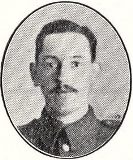
Edgar Phillips, Gunner, 156894, Royal Field Artillery. Edgar was the son of John and Rachel Phillips, of Maes-y-Gof, Lower Cwmtwrch. He enlisted at Ystradgynlais into the Royal Field Artillery and was posted to France to join B Battery, Royal Field Artillery. Edgar was reported to have served at the front for a considerable time, probably from 1916, before being invalided home as a result of suffering from gas poisoning on the Cambrai front. He died at the 3rd Northern General Hospital, Sheffield, on 14 October 1918, aged 23, and his remains were brought home for burial in Cwm-Twrch Isaf (Bethania) Calvinistic Methodist Chapelyard.
Herbert John Pollard, Private, 368194, Royal Army Medical Corps. Herbert was the son of Frederick and Elizabeth Pollard, of 113 Oxford Street, Totterdown, Bristol. He worked as a Porter for the GWR at Ystalyfera prior to the war and married Maggie Griffiths, of Pantteg, Ystalyfera in 1914. Herbert enlisted at Ystradgynlais on 5 October 1914 into the South Wales Borderers and was posted to the Depot at Brecon where he was taken on strength by the 5th Battalion, South Wales Borderers. Within three weeks Herbert was discharged as medically unfit. Undeterred he re-enlisted into the Royal Army Medical Corps and was posted to the 1st/3rd Welsh Field Ambulance, which was attached to the 53rd (Welsh) Division. He landed in Egypt with his unit on 20 December 1915, as the division was being evacuated from Gallipoli, and took part in the campaigns in Egypt and the Palestinian offensive. Despite setbacks at the failed First and Second Battles of Gaza in 1917, later that year the Third Battle of Gaza proved a success which led to the capture of Jerusalem, before the British continued to drive the Turks northwards out of Palestine. Herbert was wounded during the final months of the campaign and died of his wounds at the 66th Casualty Clearing Station on 13 April 1918, aged 27. He is buried in grave W.88. in Jerusalem War Cemetery, Israel.
Edward Arnold Price, Private, 260107, Cheshire Regiment. Edward was born in Llandovery, the son of Arthur and Wilhelmina Price. The family later resided at 281, Tarreni Terrace, Godrergraig, Swansea. He enlisted at Aberdare into the 13th Battalion, Cheshire Regiment, which was part of 74 Brigade, 25th Division. The Division crossed to France during September 1915, and were moved into positions near Vimy Ridge, where they remained until June 1916. They then moved south to Warloy, and they took part in an assault near Thiepval on 3 July 1916 and remained on the Somme until moving to Ploegsteert in November 1916. They fought during Third Ypres, at the Battle of Messines and then moved to Pilckem to take part in the assault there. Edward was killed in Action during at Ypres, on 10 August 1917, aged just 19, and is commemorated on panel 19-22 of the Ypres (Menin Gate) Memorial, Belgium.
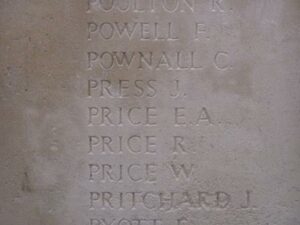
Robert Read, DCM, Sergeant, 355546, Royal Welsh Fusiliers. Robert was born at Ystalyfera, the son of John and Margaret Read. By 1891 the family had moved to Glyncorrwg and Robert married in 1903, living with his wife Elizabeth and their two children at 42, Jersey Road, Blaengwynfi, where Robert had his own Butcher’s Shop. Robert enlisted at Cardiff into the Welsh Horse Yeomanry on 18 August 1914, stating that had previously served with the Pembroke Yeomanry. On 24 September 1915 Robert landed at Gallipoli with the Welsh Horse, serving there until being struck by bullets in his side and knee just before the battalion was evacuated to Egypt. On 4 March 1917 the Welsh Horse was merged with the Montgomery Yeomanry to form the 25th Battalion, Royal Welsh Fusiliers, and was attached to the 53rd (Welsh) Division. Robert re-joined the battalion after recovering from his wounds and took part in the Palestinian campaign. He was killed in action during the Third Battle of Gaza, on 31 October 1917, aged 38. Robert is buried in grave K.3. in Beersheba War Cemetery, Israel. He had been awarded the Distinguished Conduct Medal during one operation in Palestine. The citation for his award was published in the London Gazette of 18 February 1918, after his death, and read: ‘For conspicuous gallantry and devotion to duty during a raid. Though he was wounded, he went to the assistance of a wounded officer, and showed great determination and self-sacrifice.’ Robert does not appear to be commemorated locally.
Edward Rees, Lance Corporal, 6098, Welsh Regiment. Edward was the husband of Mary Ann Rees, of 22, Gnoll Road, Godrergraig. He was an army reservist who had served during the Boer War of 1899-1902 and re-joined the 2nd Battalion, Welsh Regiment soon after the outbreak of war. Edward embarked for France on 10 November 1914 to join the battalion, which was at Ypres attached to 3 Brigade, 1st Division and had seen heavy fighting during the retreat from Mons to the Marne and during the First Battle of Ypres. The following year saw the division in action again at the Battle of Aubers, before moving South to Loos, where it fought during the Battle of Loos, and the action at the Hohenzollern redoubt. During July 1916 the division marched south to the Somme, where it fought throughout the Somme Offensive. It followed the German retreat to the Hindenburg Line in early 1917 and was then briefed for an operation on the Flanders Coast, moving there during the summer of 1917. While training on the coast, the Battle of Third Ypres had stalled in the mire, and the Division was recalled to Ypres, where it fought at the Second Battle of Passchendaele. Edward was killed in action at Ypres on 9 November 1917, aged 36, while 3 Brigade was assembling in preparation for an assault on the following day. He has no known grave and is commemorated on panels 93-94 of the Tyne Cot Memorial, Belgium.
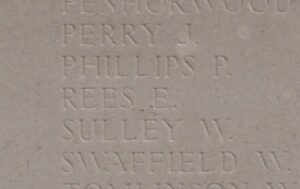
William Rickard. William cannot presently be identified but he reportedly worked at the Tarreni Colliery prior to the war and enlisted in October 1914. He lived at Godrergraig.
Douglas Parker Robathan, Captain, Welsh Regiment. Douglas was born on 28 January 1888, the son of George Beckett Robathan and Frances Elizabeth Robathan, of The Gove, Risca, Monmouth. He was educated at Llandaff Cathedral School and Cranbrook School Kent, before becoming a mining engineer and assistant manager at the Tarreni Colliery. He was commissioned into the Monmouthshire Regiment in January 1908 and transferred to the 5th Battalion, Welsh Regiment in April 1909 and by the outbreak of war had been promoted Captain. Douglas volunteered to serve overseas with the 5th Welsh and embarked with the 53rd (Welsh) Division for Gallipoli in July 1915. The division landed at Suvla Bay on 9 August 1915 and the battalions were sent into the bush towards the front line, with no maps. Douglas was killed in action during fierce fighting on the following day, 10 August 1915, aged 28. He has no known grave and is commemorated on panel 140 to 144 of the Helles Memorial, Gallipoli. One of his fellow officers wrote of his death: ‘Devoted to his duty and always to be relied on… lying on the ground he still cheered his men on – Stick it Welsh, he shouted, and kept on shouting until another bullet came along and got him in the lung. He died the best death any man could die and as game as possible.’
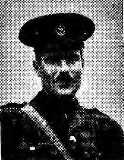
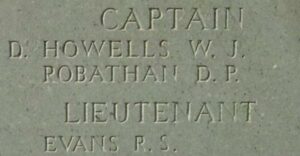
John Samuel, Rifleman, C/9339, King’s Royal Rifle Corps. John was the son of David and Matilda Samuel, of 56, Wern Road, Ystalyfera. He enlisted at Woolwich into the 20th Battalion, King’s Royal Rifle Corps (British Empire League Pioneers), which landed in France on 30 March 1916 before being attached to the 3rd Division as its Pioneer Battalion. He saw action during the divisions time on the Somme in 1916. By May 1917 the Division was at Arras and fought at the First and Second Battles of the Scarpe, and at the Battle of Arleux and the Third Battle of the Scarpe, where it captured Roeux. Then the division moved to Ypres and fought during the later stages of the Third Battle of Ypres. In November the Division moved south again, where it fought at the Battle of Cambrai, and it was in the area during March 1918 when the German Spring Offensive swept through the British lines from 21 March, seeing heavy fighting in the coming days. The battered division was among a number of depleted units moved to Flanders to rebuild, but became caught up in more fighting following the launch of the Germans second offensive of the year, on the Lys Valley. John was killed in action in France whilst reportedly attached to the American Army on 26 May 1918, aged 28. He is buried in grave III.A.21. in Chocques Military Cemetery, France. John does not appear to be commemorated locally.
Albert Smith, Private, 76582, Royal Welsh Fusiliers. Albert was born at Ystalyfera in 1895, the son of Frederick and Mary Smith. His family later resided in Ailybryn, Ystradgynlais, while Albert moved to Cefn Coed to work at the Cyfarthfa Colliery, and he married Margaret Thomas, of 157, High Street, Cefn Coed. Albert enlisted into the army and was posted to the 3rd (Garrison) Battalion, Royal Welsh Fusiliers at Pembroke Dock. By the beginning of May 1918 Albert had taken ill and was brought to Pembroke Dock Military Hospital, where he died on 19 May 1918, aged 23. His remains were brought home to Cefn Coed and he was buried with full military honours in grave A.8.33. in Merthyr Tydfil (Ffrwd) Cemetery, Penderyn, Wales. Albert does not appear to be commemorated locally.
Charles Ernest Symonds, Private, 2305, South Wales Borderers. Charles was the son of Charles Ernest and Emma Symonds, of Cheltenham. His father worked as a gardener and had moved the family to St. Fagan’s by 1901. Charles followed in his father’s profession and by 1911 was working as an under gardener at The Gnoll, Neath, and by the outbreak of the war lived at Yniscedwen House, Ystalyfera. He enlisted at Brecon into the Brecknockshire Battalion, South Wales Borderers, and embarked for Bombay with the battalion on 29 October 1914. On 3 December 1914 the battalion moved to Aden, arriving 16 December 1914 and coming under orders of the Aden Brigade. The battalion was ordered to make a desert march to Lahej, as part of the Aden Movable Column, losing twenty men to heat stroke before the Turks were even encountered. Charles was among those who died under terrible conditions in Aden, when he died on 4 July 1915, aged 24. He is commemorated on the Heliopolis (Aden) Memorial, Egypt. Charles is also commemorated on a memorial plaque which was unveiled by the members of his battalion in the Garrison Church at Aden.
Richard Reginald Rees Taylor, Private, 125797, Machine Gun Corps. Richard, known as Reginald, was the son of William and Annie Taylor, of 6 Midland Terrace, Lower Cwmtwrch. He enlisted at Brecon into the Monmouthshire Regiment, and was posted to France, joining the 51st Battalion, Machine Gun Corps, which formed on 19 February 1918, attached to the 51st (Highland) Division. The division was in positions near Flesquières when Reginald joined it and was hit hard by the German offensive of 21 March 1918. The battered division was moved to Bethune to rebuild and rest, but was caught up in another offensive, the Battle of the Lys, which was launched on 9 April 1918, and saw heavy fighting around Richebourg Saint-Vaast. At the beginning of May, the Division moved to Oppy near Arras, where it stayed until 11 July, but following another German offensive to the south, the Battle of the Aisne, was sent to assist the beleaguered divisions there. Reginald was killed in action on the Aisne on 28 July 1918, aged 20. He has no known grave and is commemorated on the Soissons Memorial, France.
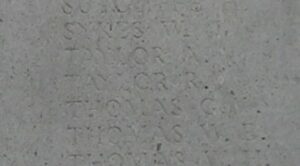
David Thomas, Private, 17891, Welsh Regiment. David was the husband of Margaret Thomas, of Cyllie Farm, Upper Cwmtwrch. He enlisted at Swansea into the 14th Battalion, Welsh Regiment (Swansea Pals), which trained at Rhyl and Winchester before embarking for France on 2 December 1915 attached to 114 Brigade, 38th (Welsh) Division. The entire Division moved to the Fleurbaix sector, where it was initiated into trench warfare. During June 1916 the Division marched south to the Somme, and on 7 July 1916 attacked Mametz Wood. The initial attack failed, and it was three days later, on 10 July, that a fresh attack was mounted. David was among hundreds of men killed during the fierce fighting which followed, on 10 July 1916. The 41-year-old is buried in grave VIII.I.1. in Dantzig Alley British Cemetery, Mametz, France.
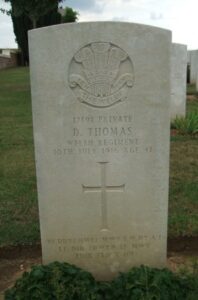
James Thomas, Private, 21078, Royal Welsh Fusiliers. James was born in Llanguicke, the son of William Thomas. James lived in Mount Hill, Panteg, Ystalyfera prior to enlisting at Ystalyfera into the 14th Battalion, Royal Welsh Fusiliers, which was attached to 113 Brigade, 38th (Welsh) Division. He landed in France with the battalion on 2 December 1915, and the division spent its first winter in the trenches near Armentieres. In June it marched south to the Somme, where they were tasked with the capture of Mametz Wood. The attack on the wood began on 7 July, but met with fierce resistance, and it took until 12 July to totally clear the wood. The Division suffered terrible casualties at Mametz, and was taken out of the line, moving to positions north of Ypres, alongside the Boesinghe Canal, to rebuild. Here it remained for almost twelve months before taking part in the Battle of Pilckem Ridge, which was launched at dawn on 31 July 1917. James was killed in action during the consolidation of the ridge on 2 August 1917. He has no known grave and is commemorated on panel 22 of the Ypres (Menin Gate) Memorial, Belgium.
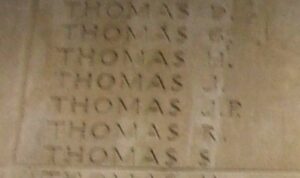
Edward John Trussler, Private, 16921, South Wales Borderers. Edward was born in Lambeth on 28 February 1884, the son of John and Anne Trussler. He worked for the GWR as a signalman and was posted to Ystalyfera, where he married Hephzibah Mary Walters on 22 September 1906 and the family resided at 6, Woodman’s Terrace, Ystalyfera. Edward enlisted at Ystradgynlais on 7 September 1914 into the 5th Battalion, South Wales Borderers and stated on his attestation form that he had previously served with the Hampshire Regiment, presumably before joining the GWR. On 16 December 1914 Edward was discharged after being deemed not likely to become an efficient soldier, and returned home to Ystalyfera, where he slowly became ill and died on 28 July 1917, aged 32. He was buried in Holy Trinity Churchyard at Ystalyfera. Edward is not eligible for commemoration by the CWGC because his death was not service related.
Daniel Charles Weston, Private, 17818, Welsh Regiment. Daniel was the son of Albert and Sarah Weston, of Bryn Derwen, Lower Cwmtwrch. He was one of eight men from Cwmtwrch who enlisted at Ystalyfera in November 1914 into the 14th Battalion, Welsh Regiment, which was known as the Swansea Pals, and trained at Rhyl and Winchester before landing in France on 2 December 1915 attached to 114 Brigade, 38th (Welsh) Division. The division was initiated into the arts of trench warfare in the Fleurbaix sector, before holding the line itself at Cuinchy, and near Neuve Chapelle, where Daniel was wounded by shrapnel just a month after, on 27 January 1916. He spent several weeks in hospital before re-joining the battalion in time to take part in the famous attack by the 38th (Welsh) Division on Mametz Wood in July 1916. The division was moved from the Somme at the end of July and took up positions at Boesinghe, north of Ypres, where it spent the next twelve months before taking part in the Battle of Pilckem Ridge on 31 July 1917. It wintered in the Armentieres sector before being sent back to the Somme in March 1918 to hold the stretched line north of Albert, overlooking the Ancre Valley and Aveluy Wood. From 21 August 1918 the division launched an assault across the Ancre, capturing Thiepval Ridge and Pozieres before advancing across the old Somme battlefields and driving towards the Hindenburg Line. Daniel almost survived the entire war but was unfortunately killed by shrapnel four days before the Armistice, on 7 November 1918, aged 23. He is buried in grave I.D.18. in Dourlers Communal Cemetery Extension, France.
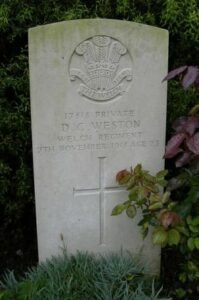
Timothy Whelton, Private, 24410, Welsh Regiment. Timothy was the son of Bartholomew and Mary Whelton of 109, Albert Row, Haverfordwest, and the husband of Mary Jane Whelton, of 43, Heol y Varteg Road, Ystalyfera, Swansea. He enlisted at Cwmgors into the 17th Battalion, Welsh Regiment, which was attached to 119 Brigade, 40th (Bantam) Division. This Division was formed between September and December 1915, and moved to France between 1 and 9 June 1916, moving to the front near Loos. Late in 1916 they moved south to the Somme, and fought at the Battle of the Ancre, and remained in the area over the winter. In March, 1917 the Germans withdrew to their shortened line, called the Hindenburg Line, and the 40th Division was one of the Divisions that followed the withdrawal. Later in the year they took part in the Battle of Cambrai, playing an important role in the attack on Bourlon Wood. Timothy was killed during the Battle of Cambrai, on 25 November 1917, aged 29. He is commemorated on panel 7 of the Cambrai Memorial, Louverval, France.
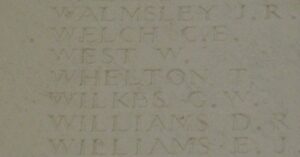
David Edward Williams, Sapper, 146081, Royal Engineers. David was born in Newcastle Emlyn, the son of Edward and Margaret Williams. He married Gwenllian Davies at Pontardawe on 17 February 1906, and the couple moved to 127, Dyffryn Clwyd, Tinman’s, Ystalyfera, with their two children. David had enlisted on 10 October 1914 into the Brecknock Battalion, South Wales Borderers, and re-enlisted at Chatham on 25 January 1916 into the Royal Engineers. David was posted to France on 12 February 1916, joining the 253rd Tunnelling Company, Royal Engineers. The Company were at work near Sailly Labourse in 1916, when David was killed in action there on the 27 April 1916. He was 30 years old and is buried in grave II.E.21. in Vermelles British Cemetery, France.
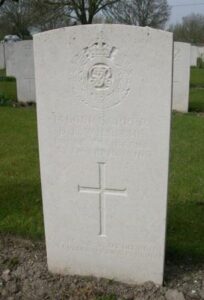
David Rees Williams, Private, 203253, Lancashire Fusiliers. David was the son of Morgan and Mary Williams, of The Bush Inn, Panteg, Ystalyfera. He enlisted at Ystalyfera into the army and was posted to the 2nd/7th Battalion, Lancashire Fusiliers, which was attached to 197 Brigade, 66th (2nd East Lancashire) Division and had landed at Le Havre on 28 February 1917. The Division concentrated on the Western Front by 16 March 1917 and moved to the Flanders Coast. At the end of September 1917, it moved to Ypres, and took part in the Battle of Poelcapelle. It then moved south to the Somme, and on 21 March 1918 was hit hard by the German Spring Offensive. David was killed during the terrible fighting that day, on 21 March 1918, aged 25. He has no known grave and is commemorated on panel 32 to 34 of the Pozieres Memorial, France.
Harry Williams, Private, 58670, Royal Army Medical Corps. Harry was born in Ystalyfera in 1885, the son of John Williams and Margaret Williams (nee Morgan). The family lived with Margaret’s sister, Jane Caswell, at Somerset House, Alltygrug Road, Ystalyfera, following the death of their father. Harry was a collier and enlisted at Newport into the Royal Army Medical Corps, before being posted to France on 23 November 1915. Harry served in France until being transferred to Egypt and boarded the requisitioned Cunard liner, RMS Transylvania at Marseilles on 3 May 1917. On the following day, 4 May 1917, Transylvania was near Savona, in the Gulf of Genoa, when she was struck by two torpedoes which had been fired by the German submarine U-63 and sank with the loss of 413 lives. Harry was 32 years old when he died during the sinking and is commemorated on the Savona Memorial, Italy. Harry does not appear to be commemorated locally.
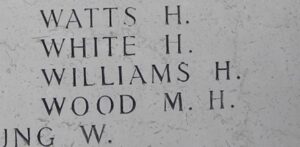
John Williams, Private, 3133, Welsh Regiment. John was the son of Gwilym and Sarah Williams, of Ystalyfera. His father died in 1903 and his mother married William Hodge in 1905, moving the family to 55, Gnoll Road, Godrergraig. John enlisted at Swansea into the 1st/6th Battalion, Welsh Regiment, and joined the battalion in France in 1916, probably following its move from Loos to the Somme in July. The battalion was the Pioneer battalion to the 1st Division, and took up positions near Munster Alley, in order to support the Australian assault on Pozieres. On the morning of 15 August 1916, the 6th Welsh left their billets at Bécourt Wood and relieved the North Staffs in Fricourt Wood, in order to carry out work on trench construction and road repairs. John was killed in action while the battalion was constructing a trench near Martinpuich that day. The 19-year-old has no known grave and is commemorated on pier and face 7A and 10A of the Thiepval Memorial, France.
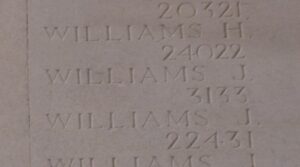
Llewelyn Oswald Williams, Lance Corporal, 53984, Royal Welsh Fusiliers. Llewelyn was the son of Griffith and Jane Williams, of Penrhiwfarteg, Ystradgynlais. He enlisted at Brecon into the Brecknock Battalion, South Wales Borderers and was posted to France, joining the 17th Battalion, Royal Welsh Fusiliers, which was attached to 113 Brigade, 38th (Welsh) Division. He probably joined the battalion at Ypres and took part in its assault on the Pilckem Ridge as well as the ensuing Battle of Langemarck. The battalion wintered in the Armentieres sector before being rushed to the Somme following the launching of the German spring offensive on 21 March and took up positions north of Albert, facing the Bouzincourt Ridge. Several fierce actions were fought over the coming months to gain control of the west bank of the River Ancre, which was used as the launching pad for the great offensive on 21 August 1918, when the division assaulted the Thiepval Ridge before taking part in the great advance towards and through the Hindenburg Line. By the first week of October 1918 the division was ready to launch an assault on the Beaurevoir Line and the high ground in front of Villers-Outreaux. Llewelyn was leading a party of men who had volunteered to storm a German machine-gun post during the opening day of the battle, on 8 October 1918, and was among eight men killed by a German Whizz-Bang. Llewelyn was 22 years old when he was killed that day and is buried in grave VI.D.5. in Prospect Hill Cemetery, Gouy, France.
Robert Williams, Gunner, 94526, Royal Garrison Artillery. Robert was the son of John and Sarah Jane Williams, of Graig Road, Banwen. He worked as a tin-plate doubler prior to enlisting into the Royal Garrison Artillery on 12 December 1915. Little else is known of him, but a newspaper report on 19 May 1917 stated: ‘Mr and Mrs. John Williams, Banwen, Alltwen, have received notification that their son. Gunner Robert Williams, of the R.G.A., has been wounded in the recent heavy fighting in France, and has had to have one leg amputated. He is progressing as well as can be expected at a base hospital. He possibly died in 1921 after having been discharged from the army as medically unfit on 20 July 1918.
Tom Williams, Able Seaman, Royal Navy. Tom was born in 1893, the son of William Williams and Esther Williams of Penrhos. He was raised by his grandparents, Lewis and Margaret Hughes, at Hen Felin, Gurnos, Ystalyfera. He had played rugby for Ystalyfera prior to the war when he enlisted into the Royal Navy and served during the Battle of Jutland on 31 May 1916. He survived the war but died at home on 5 October 1919, aged 27. Tom is buried in St. Cynog’s Churchyard, Ystradgynlais. He is not commemorated by the CWGC.
William Arthur Williams, Corporal, 6356, Cavalry. William was the grandson of Martha Richards, of the New Inn, near Marros. He appears to have been the illegitimate son of Martha’s daughter, Leah Jane Williams. William worked as a farm servant for William Ebsworth at Marros Farm before he moved to Ystalyfera and married Gladys Baber, of 22, Canal Street, Ystalyfera, in 1913. William enlisted into the 17th Lancers (Duke of Cambridge’s Own) prior to the war and landed in France on 19 October 1914, joining the 2nd Life Guards, which was under command of the 7th Cavalry Brigade, 3rd Cavalry Division. William joined up with the division in time to take part in the First Battle of Ypres, where the vastly outnumbered BEF stopped the German drive towards the Channel ports by holding the city of Ypres. The division wintered in the Ypres Salient and became caught up in another German offensive just months later, the Second Battle of Ypres, which was launched on 22 April 1915. The opening of the battle was heralded by the first use of poison gas when the Germans launched a gas attack against the French Colonial troops at Gravenstafel. Only brave fighting by the Canadians stopped a break-through, but the battle continued to rage. After weeks of continual fighting, by the second week of May William was in the front line with the 2nd Life Guards near Frezenberg Ridge. At 4 am on 13 May 1915 a heavy artillery barrage opened up on the British line around Ypres and was followed by a massed attack by the German infantry. During a terrible day of fighting, the 3rd Cavalry Division lost over 90 officers and 1,500 men. William, who was 28 years old, was among those killed on 13 May. He has no known grave and is commemorated on panel 5 of the Ypres (Menin Gate) Memorial, Belgium. His widow Gladys later remarried and lived at 4, Emma’s Buildings, Hill Street, Hull.
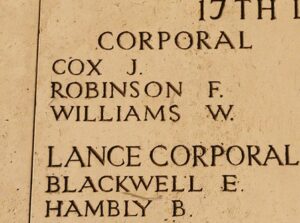
William John Woodward, Gunner, 39822, Royal Field Artillery. William was the son of Albert Victor Woodward and Sarah Ann Woodward, of Middle Lypiatt, Stroud. He was a collier who lodged at St. David’s Road, Ystalyfera prior to the war and married Elizabeth Thomas, of 4, Wind Road, Glanrhyd, in 1913. William enlisted into the Royal Field Artillery and landed in France with the 57th Battery, 45th Brigade, Royal Field Artillery on 17 August 1914. The brigade became attached to the 8th Division, which had been assembled from units from around the Empire and moved to France to reinforce the BEF. The division saw its first major action at the Battle of Neuve Chapelle, and then took part in the Battle of Aubers. It then saw further fighting at the Action of Bois Grenier, before moving to the Somme in 1916. William was wounded towards the end of the Somme offensive, and died of his wounds at the 2nd/2nd London Casualty Clearing Station, Méaulte on 28 November 1916, aged 29. He is buried in grave II.E.31. in Grove Town Cemetery, Méaulte, France.
Horace George Francis York, Lance Corporal, 1274, Welsh Guards. Horace was born on 7 October 1889, the youngest son of William Henry York and Anne York, of Southwark, London. He worked at Ystalyfera prior to the war and enlisted there into the Welsh Guards following its formation by Royal Warrant on 26 February 1915. Horace landed at Le Havre with the 1st Battalion, Welsh Guards on 18 August 1915 and the battalion become attached to 3rd Guards Brigade, Guards Division. The Division saw its first major action during the Battle of Loos on 25 September 1915, remaining in the area during the coming months, where they also fought in the subsequent Action of Hohenzollern Redoubt. In July 1916 the Division moved to the Somme, where it fought at the Battle of Flers-Courcelette, and then at the Battle of Morval, capturing Lesbouefs Village. The division remained here for the winter and spent some time at Arques before taking up positions north of Ypres, along the Boesinghe Canal, to the left of the 38th (Welsh) Division. The Guards Division then began preparations for the launching of the forthcoming assault on the Pilckem Ridge, as part of the opening assault of the Third Battle of Ypres, and on 29 July 1917 moved into the front line near Boesinghe in readiness to launch their attack on 31 July. Horace was among a number of Welsh Guardsmen killed just prior to the attack, whilst in the line on 30 July 1917. The 27-year-old has no known grave and is commemorated on panel 11 of the Ypres (Menin Gate) Memorial, Belgium.
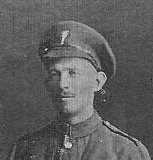
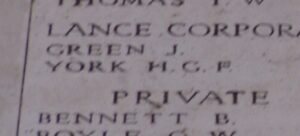
World War Two, 1939-1945
William Fishwick Antell, Sergeant, 564245, Royal Air Force. William was the son of Thomas Henry Antell and Lydia Jane Antell (nee Cartwright), of Varteg Road, Ystalyfera. He served with 99 Squadron, Royal Air Force, which was the first unit to be equipped with the Vickers Wellington. The squadron was at RAF Mildenhall at the start of the war and flew its first operational mission over Germany on 8 September 1939. It then moved to RAF Elmdon, before taking up residence at RAF Newmarket on 15 September. William was killed whilst flying in Wellington IA, Serial N2886, when it was shot down and crashed into the sea near Wangerooge whilst en-route to bomb Wilhelmshaven on 14 December 1939. The 26-year-old has no known grave and is commemorated on the Runnymede Memorial, Surrey.
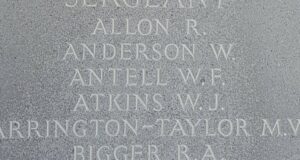
Cecil William Bonehill, Able Seaman, D/SSX 13850, Royal Navy. Cecil was born on 4 April 1914, the son of Frederick William and Margaret Bonehill (nee Evans), of 1, Gurnos Villas, Lower Cwmtwrch. He enlisted into the Royal Navy prior to the war, and served aboard the Hunt Class destroyer, HMS Hurworth. She had been commissioned on 5 November 1941 and its first operation had been to rescue Crown Prince Olaf of Norway. She then escorted ships to Gibraltar, before taking part in escort duties around Africa. Hurworth joined the Mediterranean Fleet on 6 February 1942 and was put to work on escort duties involving convoys to Malta and Tobruk. Following the landings on Sicily and Salerno, Hurworth carried on with her work. She left Alexandria on 21 October 1943 as part of the supply force in the Dodecanese islands. The following day the Greek destroyer Adrias struck a mine and was badly damaged. Hurworth steamed forward to investigate but struck a mine which set off a cataclysmic explosion which split the ship in two. Cecil was among 113 men lost in the sinking of Hurworth on 22 October 1943. The 29-year-old has no grave, and is commemorated on the Plymouth Naval Memorial, Devon.
John William Brett, Private, 3385250, Duke of Wellington’s (West Riding Regiment). John was born in Manchester, the son of William Brett. The family later resided at Ystalyfera. John enlisted into the army and served with the 1st Battalion, West Riding Regiment. The battalion had been in France with the 1st Infantry Division following the outbreak of war and took part in the retreat to Dunkirk, forming part of the rearguard before being evacuated. After being rebuilt, the division then embarked for service in North Africa, taking part in a number of actions before becoming part of the Allied force which landed in Italy in 1943 and took part in the Battle of Anzio. John was killed in Italy on 12 September 1944, during the advance on Monte Ceco. He was 31 years old and is buried in Florence War Cemetery, Italy.
Reginald Owen Clee, Warrant Officer, 1068617, Royal Air Force Volunteer Reserve. Reginald was the son of Lewis John and Elsie Margaret Clee, of Pontlliw, and had studied for his B.Sc. at the University of Wales prior to the war. He then served with 256 Squadron, RAF. The Squadron reformed in a night fighter role on 23 November 1940 at Catterick, equipped with Defiants. It then moved to Pembrey, from where it began operations in February 1941. From March 1941 it was based in the North-West to defend the Merseyside area until April 1943, when it moved to Ford. In May 1942, the Defiants were replaced by Beaufighters and a year later these were superseded by Mosquito XIIs. July 1943, saw the squadron supply a detachment to Luqa in Malta to provide night cover for the invasion of Sicily. Once the invasion of Italy was complete, the rest of the squadron arrived in Malta on October, remaining there until April 1944. Its next move was to Algeria, absorbing the Gibraltar Defence Flight equipped with Spitfires in May. Reginald was reported as missing on 27 July 1944, after his plane touched the water when descending to attack an enemy plane off Corsica. He was 23 years old, and is commemorated on the Malta Memorial, Malta.
James Glyndwr Davies, Signalman, 2357603, Royal Corps of Signals. James was the son of James and Hanna Davies, and was the husband of Lucy Davies, of 59, Wern Road, Ystalyfera. He served with the 1st Armoured Division Signals in North Africa. The division had arrived in Egypt on 13 November 1941 and took part in much of the North African campaign thereafter. James was killed during the Battle of Gazala on 30 May 1942, aged 26. He is buried in Knightsbridge War Cemetery, Acroma, Libya.
Tommy Davies, Able Seaman, D/SSX 20923, Royal Navy. Tommy was born on 27 November 1919, the son of William and Cissie Ellen Davies, of Ystalyfera. He served in the Royal Navy aboard the aircraft carrier HMS Courageous. She was an old WW1 era battlecruiser, which had been converted into an aircraft carrier between 1924 and 1930 and could carry up to 48 aircraft. Glorious was in the Mediterranean at the outbreak of war and was recalled to the Home Fleet in April 1940 to cover British forces landing in Norway. She ferried a number of aircraft to Norwegian bases over the coming weeks, but by the end of May the British had ordered a withdrawal of their forces in Norway. On 8 June 1940 Glorious left the Narvik area for Scapa Flow, escorted by two destroyers, Acasta and Ardent, but the group was intercepted by the German battleships Scharnhorst and Gneisenau at about 15.46. The Germans soon opened fire on the two destroyers, then turned their attention to Glorious, damaging her deck so that her Fairey Swordfish torpedo bombers couldn’t take off. Glorious sank at 18.10, with the loss of 1,207 lives. Tommy was amongst the dead. The 20-year-old has no known grave and is commemorated on the Plymouth Naval Memorial, Devon.
William Christmas Noel Davies, Private, 4077810, South Wales Borderers. William was the son of David and Violet Davies, of Ystalyfera, and the husband of Rosalind Davies, of Eastleigh, Hampshire. He served with the South Wales Borderers and was training in readiness to embark for India, to join the 6th Battalion, South Wales Borderers, when he was killed in an accident on 11 October 1944, aged 22. He is buried in St. David’s Church Burial Ground, at Ystalyfera.
David Kenneth Vincent Edwards, Leading Aircraftman, 1160024, Royal Air Force. David was the son of Aneurin and Margaret Ann Edwards, of Alltygrug Farm Road, later of Claremont, Penywern, Ystalyfera. He served with the Base Signal Radar Unit, Royal Air Force and had been deployed to Belgium with the unit following the successful advance of the Allies from Normandy. On 7 November 1944 David was aboard LST-420 when it struck a mine while entering Oostend Harbour, and sank with the loss of 238 lives. David was 31 years old and is buried in Oostende New Communal Cemetery, Belgium.
David Emlyn Evans, Sergeant, 655240, Royal Air Force. David was the son of Harry Edwin and Rachel Ann Evans, and the husband of Heddwen Evans, of Ystalyfera. He served with the Royal Air Force and was posted to No 42 Operational Training Unit at RAF Thruxton for pilot training. On 3 June 1942 David took off from Thruxton flying Bristol Blenheim IV, Serial Z6188 when the aircraft lost control and spun into the ground. David was killed in the resulting crash. The remains of the 24-year-old were brought home and he was buried in Coedgwilym Cemetery.
William Sydney Gibbard, Lance Corporal, 4077678, Corps of Military Police. William was the son of Alfred and Edith Maud Gibbard, of Ystalyfera. His mother died in 1927 and Alfred remarried Jane Leadbetter. William served with the Corps of Military Police, and was attached to 167 Divisional Provost Company, which was based in Cardiff. He was serving in Swansea when he was badly injured during the last air raid on Swansea, on 16 February 1943. He died the following day, on 17 February 1943, aged 23, and is buried in St. David’s Church Burial Ground, Ystalyfera.
Glyn Guerrier, Sergeant, 568519, Royal Air Force. Glyn was the son of Ebenezer and Blodwin Guerrier, of Island House, Ystalyfera and the husband of G. E. Muriel Guerrier of Croydon, Surrey. He served as a Flight Engineer with 102 Squadron, Royal Air Force, which was equipped with the Handley Page Halifax. On the night of 2 February 1943, Glyn took off from RAF Pocklington aboard Halifax II, Serial W7882, which was part of a massive force despatched to bomb Cologne. About two hours into the flight, the aircraft collided with Lancaster W4819 and both aircraft came down near Eindhoven. Glyn was 23 years old when he died that night, and is buried in Eindhoven (Woensel) General Cemetery, Netherlands.
John Spencer Harding, Motor Mechanic, C/MX 622591, Royal Navy. John was the son of William Melville Harding and Asenath Anne Harding, of Ystalyfera. He served with the Royal Navy as a Motor Mechanic and had been posted to HMS Lanka, the Royal Naval establishment at Colombo. On 5 February 1944 John sailed from Mombasa aboard the troopship Khedive Ismail, bound for Colombo carrying 1,324 passengers including 996 members of the East African Artillery’s 301st Field Regiment, 271 Royal Navy personnel, 19 WRNS, 53 nursing sisters and their matron, nine members of the First Aid Nursing Yeomanry and a war correspondent, Kenneth Gandar-Dower. She was part of Convoy KR-8. The convoy was escorted by the HMS Hawkins, HMS Paladin and HMS Petard. On the afternoon of 12 February 1944 the convoy was south-west of the Maldives when it came under attack from the Japanese submarine I-27. Two torpedoes hit Khedive Ismail which sank quickly. A rescue of the survivors was attempted whilst HMS Petard depth charged, shelled, torpedoed and finally sank I-27, which had initially dived beneath the survivors in an attempt to escape. Only 208 men and six women survived the sinking. John, who was 18 years old, is commemorated on the Chatham Naval Memorial, Kent.
Keri Harding, Lieutenant, 249243, Essex Regiment. Keri was the son of Henry Ernest and Ruth Harding, of Ystalyfera, and the husband of Vera Ruby Harding, of Bishopston, Bristol. He had been commissioned into the 1st Battalion, Essex Regiment. Keri must have then become attached to the 2nd Battalion, Essex Regiment, as he took part in the Normandy Landings. The 1st Battalion was by then in Burma. He was killed in Normandy during the opening day of Operation Tractable on 14 August 1944, aged 26. He is buried in Banneville-La-Campagne War Cemetery, France.
Thomas William Cledwin Hopkin, Corporal, 590683, Royal Air Force. Thomas was the son of Thomas and Jennet Jones. He had been fostered by his Aunt, Anne Hopkin, of Ystalyfera. He enlisted into the Royal Air Force in 1933 and had served in Iraq. Following the outbreak of war he was posted back to England and began pilot training. On 5 October 1939 Thomas was training aboard a North American Harvard Mk 1, Serial N7094, of No 2 Flight Training School when it crashed after taking off from RAF Brize Norton. The remains of the 22-year-old were brought home and he was buried in Lower Cwmtwrch (Bethania) Calvinistic Methodist Chapelyard.
Edward Alwyn Hughes, Private, 14567217, Monmouthshire Regiment. Edward was the son of Edward Clifford Hughes and Sarah Hughes, of Ystalyfera. He enlisted into the army and was posted to the 2nd Battalion, Monmouthshire Regiment, which was attached to the 53rd (Welsh) Division. The division landed on Normandy towards the end of June 1944 and took part in the break-out from the beachhead. The division then suffered terrible fighting during the Battle of the Falaise pocket. He was killed during the opening day of Operation Tractable on 14 August 1944, aged 19. Edward is buried in Banneville-La-Campagne War Cemetery, France.
Cyril Jenkins, Sergeant, 1424167, Royal Air Force Volunteer Reserve. Cyril was the son of John Haydn Jenkins and Margaret Ann Jenkins (nee Williams), of 8, New Street, Godre’rgraig. He enlisted into the Royal Air Force Volunteer Reserve and was posted to 86 Squadron, RAF. The Squadron was a Coastal Command unit, initially flying Blenheim light bombers on convoy escort duties. In June 1941 the squadron was re-equipped with the Bristol Beaufort, and began minelaying sorties. After flying reconnaissance and air-sea rescue missions for three months the squadron started anti-shipping strikes. Cyril died in Israel on 5 August 1945, aged 23. He is buried in Ramleh War Cemetery, Israel.
Cyril Gordon Jenkins, Mess Room Boy, Merchant Navy. Cyril was the son of William Morgan Jenkins and Hilda Annie Jenkins, of 165, Graig Road, Godre’rgraig. He served with the Merchant Navy, aboard the Greek registered Motor Vessel MV Kolchis. On 22 November 1940 Kolchis was sailing across the Atlantic as part of Convoy OB-244, which was unwittingly being stalked by a German submarine Wolfpack. On the following night, 23 November 1940, the Convoy came under attack and within hours, the German submarine U-123, had sunk six vessels, including MV Kolchis. Cyril was just 17 years old when he died during the sinking of Kolchis, and is commemorated on the Tower Hill Memorial, London.
David Winston Jenkins, Sergeant, 1419911, Royal Air Force. David was the son of Richard Jenkins and the late Mrs. Jenkins, of Swan Lane, Ystalyfera. He enlisted into the Royal Air Force in 1941 and served as an Air Bomber with 77 Squadron, RAF. The squadron was equipped with the Handley Page Halifax, based at RAF Elvington. On 29 January 1944 David took off from Elvington aboard Halifax V, Serial LK709, which was part of a large force which had been despatched to bomb Berlin. The aircraft was lost over Germany with all her crew. David was 23 years old when he died that night, and is buried in Berlin 1939-1945 War Cemetery, Germany.
George Kenneth Jones, Sergeant, 946977, Royal Air Force Volunteer Reserve. George was the son of Benjamin Jones and Mary Emma Jones (nee Watkins), of Ystalyfera. He enlisted into the Royal Air Force Volunteer Reserve and was posted to 224 Squadron, RAF. The Squadron was a Coastal Command unit, equipped with the Lockheed Hudson. The squadron converted to Consolidated Liberators in 1942, and by April 1943 operated from St Eval, Cornwall. George was killed when his Liberator V, Serial BZ776, was lost on an anti-submarine patrol over the Bay of Biscay on 20 March 1944. The 24-year-old is commemorated on the Runnymede Memorial, Surrey.
Islwyn Jones, Flight Sergeant, 635095, Royal Air Force. Islwyn was the son of Daniel and Evelyn Jones, of Ystalyfera. He enlisted into the Royal Air Force and was posted to Canada with the Empire Air Training Scheme before joining 112 Transport Wing. On 25 April 1944 Islwyn was flying aboard Consolidated Liberator VI, Serial EW148 en-route from Dorval, Canada to Bermuda when it struck a building in poor weather and crashed, killing all five of her crew. Islwyn was 23 years old when he was killed that day, and is buried in Montreal (Mount Royal) Cemetery, Canada.
James Douglas Jones, Flying Officer, 53112, Royal Air Force. James was the son of Thomas and Margaret Jones, of Ystalyfera. He enlisted into the Royal Air Force and was posted to 456 Squadron, which was equipped with the De Havilland Mosquito, based at RAF Middle Wallop and operated as a night fighter and long-range day fighter unit. On 24 November 1944 James was flying in Mosquito HK317, piloted by John Leonard Mulhall, when their aircraft came down in the North Sea. James was 22 years old when he died that day and is commemorated on the Runnymede Memorial, Surrey.
John Idris Jones, Leading Stoker, P/KX 80168, Royal Navy. John was born on 31 March 1910, the son of Tom and Emily Jones, of Burchell Row, Godrergraig, and the husband of Nelly Jones, of South Ealing, Middlesex. He enlisted into the Royal Navy and served aboard the aircraft carrier HMS Eagle. During the early stages of the war Eagle operated in the Indian Ocean before heading to the Mediterranean to carry out operations against the Italian Navy. John was ashore in Alexandria when he fell off a balcony and was killed on 16 July 1940. He was 30 years old and is buried in Alexandria (Chatby) Military and War Memorial Cemetery, Egypt.
William George Robert Marsh, Corporal, PLY/X 1361, Royal Marines. William was born on 16 April 1918, the son of William Andrew and Jessie Donald Marsh, of Ystalyfera. He enlisted into the Royal Marines, and was posted aboard the armoured cruiser HMS Exeter. At the outbreak of war, Exeter was assigned to patrol South American waters against German commerce raiders. Exeter was one of three British cruisers that hunted the German pocket battleship, the Admiral Graf Spee. On 13 December 1939 the British came into contact with the Graf Spee, and began an action known as the Battle of the River Plate. Exeter was severely damaged during the battle, losing 61 men killed and 23 more wounded, but she managed to limp away to the Falklands for emergency repairs, before heading back to England. The Graf Spee was infamously scuttled off Montevideo by her Kapitan, Hans Langsdorff on 17 December to prevent further loss of life among his crew. William was 21 years old when he was killed in the Battle of the River Plate, and is commemorated on the Plymouth Naval Memorial, Devon.
Walter Bertram Mathias, Flying Officer, 132878, Royal Air Force Volunteer Reserve. Walter was the son of William Arthur and Mabel Emma Mathias (nee Locke), of Ystalyfera. He enlisted into the Royal Naval Volunteer Reserve and was posted to 39 Squadron RAF, which had been formed at RAF Hatfield, equipped with Westland Lysanders, before re-equipping with Curtiss Tomahawks and Hawker Hurricanes. The squadron then converted to North American P-51 Mustangs in May 1942 and began ground attack and reconnaissance operations over Northern France, which lasted till August 1943, when it moved to Ayr to train as a night-fighter unit, re-equipping with the Bristol Beaufighter. Walter was killed during operations in the Mediterranean on 27 March 1944. The 21-year-old has no known grave and is commemorated on the Malta Memorial, Malta.
James Phillips, Private, 6028707, Cambridgeshire Regiment. James was the son of Phillip and Margret Phillips, of Ystalyfera. He served with the 2nd Battalion, Cambridgeshire Regiment. The battalion was in Dumfires early in 1941, before joining Southern Command, and moved to Crewe Hall, Cheshire. Training was carried out near Ruabon Mountain before orders were received to embark for overseas. The battalion sailed for Singapore on 31 October 1941 and upon arrival reinforced the 15th Indian Brigade at Batu Pahat. Following the Japanese invasion of Malaya, the brigade held the town under heavy pressure for ten days, before a party of 500 men left and fought their way back to Singapore, just before the surrender on 15 February 1942. James was among 85,000 men taken prisoner by the Japanese following the humiliating surrender and was sent to Thailand with many other men to work on the infamous Thai-Burma Railway. The Japanese needed slave labour back in Japan also, so large numbers of PoW’s were conveyed back to their homeland from Thailand by ‘Hell Ships’ under terrible conditions. James was taken aboard one such Hell Ship, the Toyofuku Maru, which formed part of a large convoy of Japanese ships carrying over 5,000 Allied PoW’s, carrying them to forced labour camps in Japan. On 20 September 1944 the convoy was sighted and attacked by a large force of American carrier planes, and all eleven ships in the convoy were sunk. Among the thousands of Allied troops lost was James. The 34-year-old has no known grave and is commemorated on the Singapore Memorial, Singapore.
Randell Powell, Private, 13001434, Pioneer Corps. Randell was the son of Richard James Powell and Mary Hannah Powell, of Ystalyfera. He enlisted into the army prior to the war and served with the 50th Auxiliary Company, Pioneer Corps. His unit was in France with the BEF at the outbreak of war and involved in the withdrawal to the evacuation ports, namely Dunkirk, Calais, Boulogne and St. Nazaire. Randell and his unit had managed to make it safely back to St. Nazaire where he boarded the Cunard liner RMS Lancastria. The situation in France was desperate, and by some accounts almost 6,000 people had crammed aboard the liner, hoping to be ferried to safety. Sadly the liner was spotted by German aircraft and was bombed and sunk off St. Nazaire, becoming the largest ever loss of life at sea in British maritime history. Randell was 36-years-old when he was killed in the sinking of Lancastria on 17 June 1940. He has no known grave and is commemorated on the Dunkirk Memorial, France. He was one of two men of Ystalyfera aboard Lancastria.
Robert John Purser, Bombardier, 1737791, Royal Artillery. Robert was the son of John and Annie Purser, and the husband of Ethel Ivy Purser, of Ystalyfera. He served with 100 Battery, 52nd Light Anti-Aircraft Regiment, Royal Artillery. The regiment had seen service in Scotland during the Blitz, before being assigned to the 1st Army for Operation Torch, the landings on North Africa. After the German surrender on 12 May 1943, preparations began for landing on the Italian coast, and the regiment took part in what became known as Operation Husky. Robert was killed in Italy on 11 November 1943, aged 37. He is buried in Minturno War Cemetery.
John Malcolm Roberts, Aircraftman 1st Class, 634663, Royal Air Force Volunteer Reserve. John was the son of George Ernest and Elizabeth Roberts, of Swansea. He was in France with the BEF at the outbreak of war and involved in the withdrawal to the evacuation ports, managing to safely reach St. Nazaire. John boarded the Cunard liner RMS Lancastria. The situation in France was desperate, and by some accounts almost 6,000 people had crammed aboard the liner, hoping to be ferried to safety. Sadly, the liner was spotted by German aircraft and was bombed and sunk off St. Nazaire, becoming the largest ever loss of life at sea in British maritime history. John was just 18-years-old when he was killed in the sinking of Lancastria on 17 June 1940. He has no known grave and is commemorated on the Runnymede Memorial, Surrey. The CWGC record his death as being on 25 June 1940, but according to Lusitania expert Brian Crabb, he was aboard the ill-fated ship, one of two men from Ystalyfera.
Albert Thomas, Sergeant, 1652801, Royal Air Force Volunteer Reserve. Albert was the son of John and Gwen Thomas, of Ystalyfera. He served with the Royal Air Force Volunteer Reserve, and had been posted to 35 Squadron, RAF. The squadron became the first to be equipped with the Handley Page Halifax, before being selected to become one of the elite Pathfinder Squadrons, and converted to the Avro Lancaster. During the afternoon of 24 December 1944, Albert took off from RAF Graveley aboard Lancaster III, Serial PB366, which was to be one of a large force ordered to bomb Cologne. Sadly just after taking off, the Lancaster crashed into trees and exploded, killing all her crew of seven. Albert was 23 years old when he was killed that day and is buried in St. David’s Church Burial Ground, Ystalyfera.
Glyndwr Thomas, MiD, Major, 17702, Royal Engineers. Glyndwr was born at Ystalyfera on 16 February 1899, the son of Reverend David Lewis Thomas and Catherine Ann Thomas. His father later became Rector of Merthyr Cynog, Breconshire, and Glyndwr was educated at Christ College. He probably served during the Great War, as by 1922 he was serving as a Lieutenant with the Royal Engineers. Glyndwr married Evelyn Vera Reynolds, of Haverfordwest, on 5 February 1925. By this time his father had become Rector of Cockett, in Swansea. Glyndwr and Evelyn set up home together at The Cottage, Yiewsley, Middlesex. Glyndwr served continuously with the Royal Engineers over the coming years, then in 1939 was drafted to France with the 17th Field Company, Royal Engineers. The Company was part of the BEF and was situated on the border with Germany when the Germans launched their Blitzkrieg on 10 May 1940. The Allies began to withdraw in the face of the vicious German onslaught, back towards the Channel coast. Glyndwr was killed during the withdrawal, on 1 June 1940. The 41-year-old has no known grave and is commemorated on the Dunkirk Memorial, France. Glyndwr is not commemorated at Ystalyfera, but is named on the Christ College war memorial.
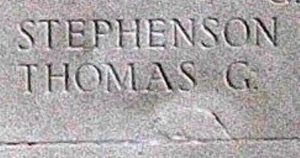
Donald Wade, Private, 5577272, The King’s Regiment (Liverpool). Donald was the son of Stanley and Dorothy Wade, of 3, Lower Wern Road, Pontardawe. He enlisted into the army and was posted to the 8th (Irish) Battalion, The King’s Regiment (Liverpool). The battalion was a TA unit, which had been selected to form part of the 7th Beach Group during the Normandy Landings. The Group landed at Juno Beach at dawn on 6 June 1944 and took part in heavy fighting alongside the Canadians. The battalion remained with the Beach Group for seven weeks until being torn apart to reinforce other units. It is unsure which unit Donald was transferred to, but he survived the war and after the Armistice of 8 May 1945 was stationed in Germany. He died in Germany on 13 June 1945, aged 22, and is buried in Celle War Cemetery, Germany.
Leslie Hardy Waite, Corporal, 5573779, The Parachute Regiment. Leslie was the son of Arthur Hardy Waite and Elizabeth May Waite, of Wade Avenue, Ystalyfera. He married Christabel Kathleen Perry, of Wells, Somerset in 1938. He had enlisted into the 10th Battalion, Royal Welch Fusiliers. The battalion was converted to the 6th Battalion, The Parachute Regiment in 1942. The battalion’s first combat action was in 1943, when it participated in an amphibious landing, Operation Slapstick, at the port of Taranto in Italy. When the 1st Airborne Division left Italy, the battalion, still with the 2nd Parachute Brigade, remained behind, where it took part in the Battle of Monte Cassino. The battalion’s first combat parachute jump was during Operation Dragoon the Allied invasion of the south of France. After this operation the battalion returned to Italy. Leslie remained in France, however, and jumped into Arnhem during Operation Market Garden on 17 September 1944. Leslie was killed at Arnhem on 23 September 1944, aged 29. He is buried in Arnhem Oosterbeek War Cemetery, Netherlands. Leslie was Mentioned in Despatches after his death, and the award was published in the London Gazette of 10 May 1945.
Emrys Walters, Private, 1468158, Monmouthshire Regiment. Emrys was the son of David and Elizabeth Walters, of Ystalyfera. He served with the 2nd Battalion, Monmouthshire Regiment, which was attached to the 53rd (Welsh) Division. The Division landed at Normandy towards the end of June 1944 and took part in the terrible fighting in the Bocage, before taking part in the advance through Northern France into Belgium and Holland. It took part in Operation Market Garden, and fought across Holland into Germany, taking part in an operation during the Battle of the Bulge which helped save the encircled Americans in the Ardennes. Emrys was killed during heavy fighting near the Reichswald Forest, near the village of Weeze, on 25 February 1945, aged 20. He is buried in Reichswald Forest War Cemetery, Germany.
Ieuan Heddwyn Williams, Sergeant, 1317507, Royal Air Force Volunteer Reserve. Ieuan was the son of Ben and Harriet Ann Williams, of Godre’r Graig. He enlisted into the Royal Air Force Volunteer Reserve, and was posted to the USA to train as a Pilot under the Empire Air Training Scheme. Upon his return he undertook further training. On 31 October 1942 Ieuan was flying Airspeed Oxford I, Serial BG665 when it struck a house whilst training at low altitude. The aircraft rolled over and struck a second house before exploding, killing Ieuan and his co-pilot. Ieuan was 21-years-old when he died that day, and is buried in Godrer’Graig Independent Chapelyard.